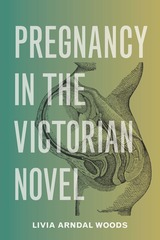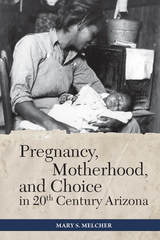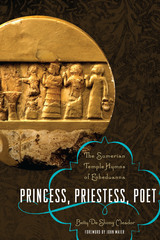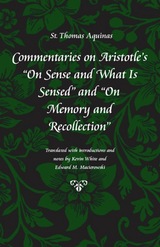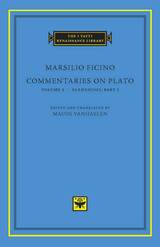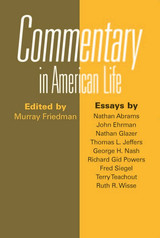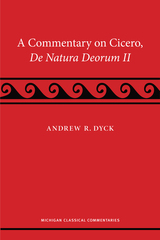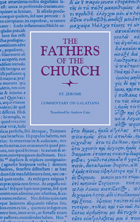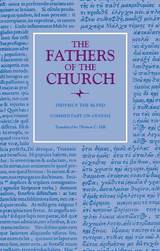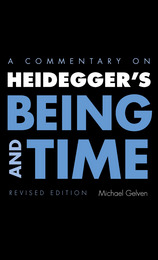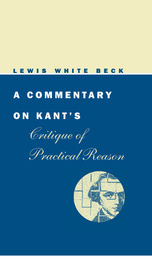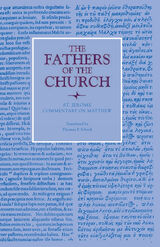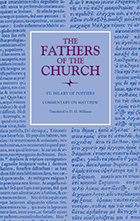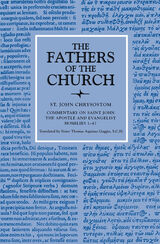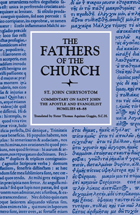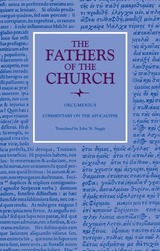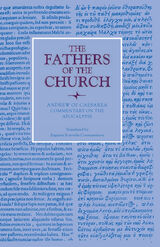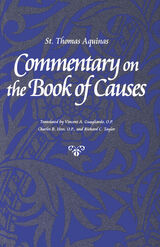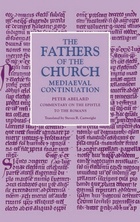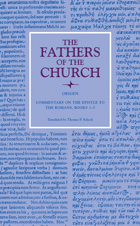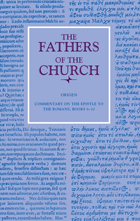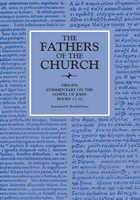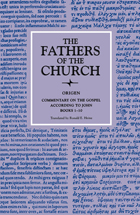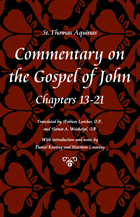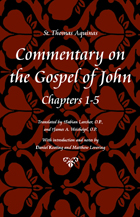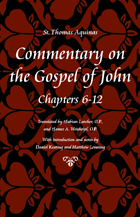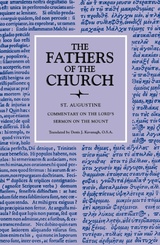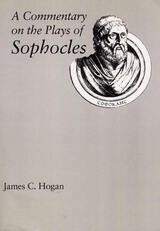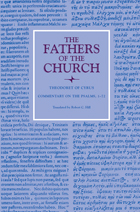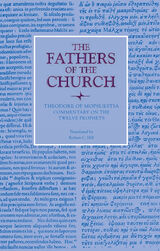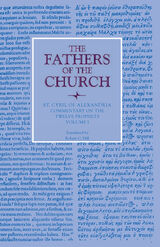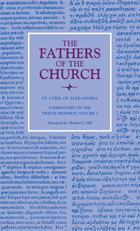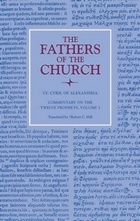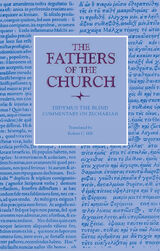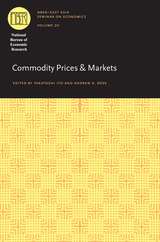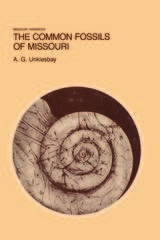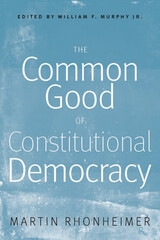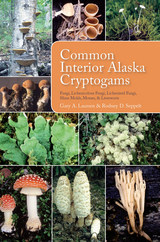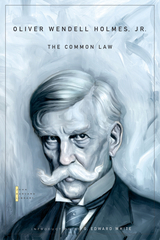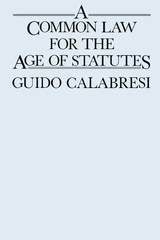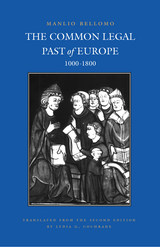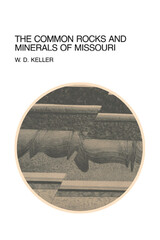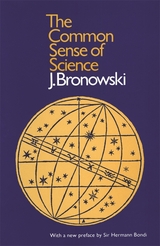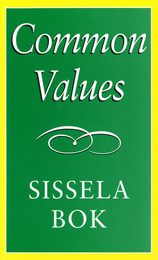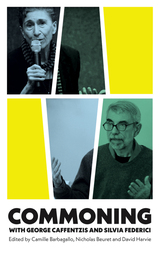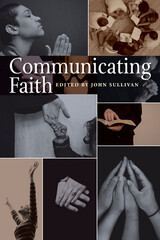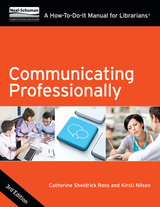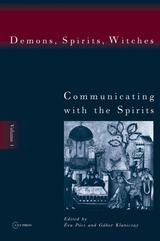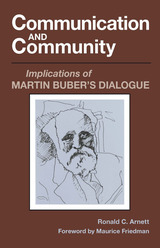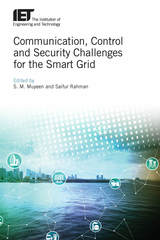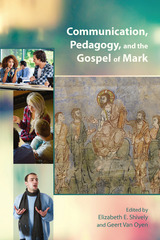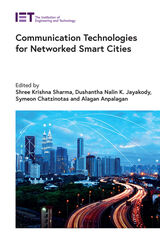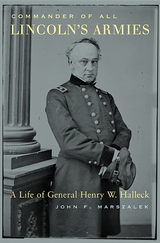 Commander of All Lincoln’s Armies: A Life of General Henry W. Halleck
John F. Marszalek
Harvard University Press, 2004 In the summer of 1862, President Lincoln called General Henry W. Halleck to Washington, D.C., to take command of all Union armies in the death struggle against the Confederacy. For the next two turbulent years, Halleck was Lincoln's chief war advisor, the man the President deferred to in all military matters. Yet, despite the fact that he was commanding general far longer than his successor, Ulysses S. Grant, he is remembered only as a failed man, ignored by posterity.
In the first comprehensive biography of Halleck, the prize-winning historian John F. Marszalek recreates the life of a man of enormous achievement who bungled his most important mission. When Lincoln summoned him to the nation's capital, Halleck boasted outstanding qualifications as a military theorist, a legal scholar, a brave soldier, and a California entrepreneur. Yet in the thick of battle, he couldn't make essential decisions. Unable to produce victory for the Union forces, he saw his power become subsumed by Grant's emergent leadership, a loss that paved the way for Halleck's path to obscurity.
Harnessing previously unused research, as well as the insights of modern medicine and psychology, Marszalek unearths the seeds of Halleck's fatal wartime indecisiveness in personality traits and health problems. In this brilliant dissection of a rich and disappointed life, we gain new understanding of how the key decisions of the Civil War were taken, as well as insight into the making of effective military leadership.
 Comme on dit: Première année de français, Student's Edition
Claude Grangier and Nadine O. Di Vito
Georgetown University Press, 2018 E-Textbooks are now available to purchase or rent through VitalSource.com! Please visit VitalSource for more information on pricing and availability. As of January 1, 2021, the Smart Sparrow Companion Websites are no longer available. Soon, we will announce a new set of companion websites. Demos for the new companion websites will be available for instructors to sample beginning in spring 2021. The complete websites will be ready in time for students to use them during the fall 2021 semester. Until the new companion websites become available, eBook Workbooks with exercises from the Smart Sparrow Electronic Workbook are available for purchase on the GUP website and VitalSource.com, as are Workbook Answer Keys. They will both be sold in eBook format only. Comme on dit, a comprehensive first-year French textbook program, engages students in the learning process from day one using an inductive methodology centered on guided observation and rule discovery. Together with students’ communicative needs and an analysis of their most pervasive transfer errors from English, the everyday speech patterns of 100 native speakers—culled from 150 hours of unscripted recordings—form the linguistic backbone of the method. Using a workbook format, students examine, compare, and contrast this wide variety of authentic discourse to discover both individual and shared language use and cultural perspectives. Additionally, students systematically and progressively acquire the fundamental sounds and rhythmic patterns of spoken French, which leads them to develop solid pronunciation and conversational fluency as well as notable listening comprehension skills. To aid instructors in effectively implementing this distinctive approach, the Teacher’s Edition textbook comes with answers for all activities, plus teaching notes in the margins and extensive ancillary resources online. By the end of one academic year, students with no prior French instruction can expect to achieve Intermediate-Mid to Intermediate-High proficiency on the ACTFL scale. Features of Comme on dit: • Emphasis on providing students with the tools and skills to help them communicate early on about topics relevant to them and their daily lives• Equal focus on all four major skill areas—reading, writing, listening, and speaking—and on the establishment of a solid grammatical and lexical foundation• Over 1,000 audio and video files, giving students ample material to practice listening to French as it is spoken by native speakers• Over 250 snippets of written authentic discourse, ranging from book titles to proverbs• Teacher’s Edition textbook with answers for all activities, plus teaching notes in the margins• Extensive ancillary instructor’s resources, including an instructor’s manual, quizzes, sample midterm and final exams, available at CommeOnDitTextbook.com For Instructors: To sample the eTextbook, please visit VitalSource.com to create an account. After you login, you may request a free copy by clicking on "Faculty Sampling" in the upper right-hand corner, searching for the "Digital Exam Copy," and selecting "Request Sample".
 Comme on dit with website: Première année de français
Claude Grangier and Nadine O'Connor Di Vito
Georgetown University Press, 2023 Comme on dit with website, a comprehensive first-year French textbook program, engages students in the learning process from day one using an inductive methodology centered on guided observation and rule discovery. Together with students' communicative needs and an analysis of their most pervasive transfer errors from English, the everyday speech patterns of 100 native speakers—culled from 150 hours of unscripted recordings—form the linguistic backbone of the method. The accompanying companion website–included with the book–offers audio and fully integrated exercises to use alongside the text. Students examine, compare, and contrast this wide variety of authentic discourse to discover both individual and shared language use and cultural perspectives. Additionally, students systematically and progressively acquire the fundamental sounds and rhythmic patterns of spoken French, which leads them to develop solid pronunciation and conversational fluency as well as notable listening comprehension skills. By the end of one academic year, students with no prior French instruction can expect to achieve Intermediate-Mid to Intermediate-High proficiency on the ACTFL scale. To aid instructors in effectively implementing this distinctive approach, the Teacher's Edition textbook comes with answers for all activities, plus teaching notes in the margins and extensive ancillary resources online. Features • Emphasis on providing students with the tools and skills to help them communicate early on about topics relevant to them and their daily lives • Equal focus on all four major skill areas—reading, writing, listening, and speaking—and on the establishment of a solid grammatical and lexical foundation • Over 1,000 audio and video files, giving students ample material to practice listening to French as it is spoken by native speakers • Over 250 snippets of written authentic discourse, ranging from book titles to proverbs
For Instructors: Please submit print exam and desk copy requests for the Teacher’s Edition using ISBN 978-1-64712-212-6. The Teacher’s Edition includes answers for all activities, plus teaching notes in the margins.
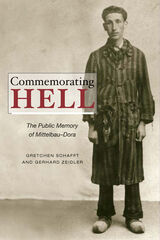 Commemorating Hell: The Public Memory of Mittelbau-Dora
Gretchen Schafft and Gerhard Zeidler
University of Illinois Press, 2011 This powerful, wide-ranging history of the Nazi concentration camp Mittelbau-Dora is the first book to analyze how memory of the Third Reich evolved throughout changes in the German regime from World War II to the present. Building on intimate knowledge of the history of the camp, where a third of the 60,000 prisoners did not survive the war, Gretchen Schafft and Gerhard Zeidler examine the political and cultural aspects of the camp's memorialization in East Germany and, after 1989, in unified Germany. Prisoners at Mittelbau-Dora built the V-1 and V-2 missiles, some of them coming into direct contact with Wernher von Braun and Arthur Rudolph, who later became leading engineers in the U.S. space program. Through the continuing story of Mittelbau-Dora, from its operation as a labor camp to its social construction as a monument, Schafft and Zeidler reflect an abiding interest in the memory and commemoration of notorious national events. In extending the analysis of Mittelbau-Dora into post-war and present-day Germany, Commemorating Hell uncovers the intricate relationship between the politics of memory and broader state and global politics, revealing insights about the camp's relationship to the American space pioneers and the fate of the nearby city of Nordhausen.
 Commentaries
Pius II
Harvard University Press, 2003 The Renaissance popes were among the most enlightened and generous patrons of arts and letters in the Europe of their day. The diaries of Pius II give us an intimate glimpse of the life and thought of one of the greatest of the Renaissance popes. Pius II (1405–1464) began life as Aeneas Silvius Piccolomini in a small town near Siena and became a famous Latin poet and diplomat. Originally an opponent of the papacy as well as something of a libertine, Aeneas eventually reconciled himself with the Roman church and became a priest, then a cardinal. Finally he was elected Pope Pius II (1458) and dedicated his pontificate to organizing a pan-European crusade against the Ottoman Empire. Pius’s Commentaries, the only autobiography ever written by a pope, was composed in elegant humanistic Latin modeled on Caesar and Cicero. This edition contains a fresh Latin text based on the last manuscript written in Pius’s lifetime and an updated and corrected version of the 1937 translation by Florence Alden Gragg.
 Commentaries
Pius II
Harvard University Press, 2003 The Renaissance popes were among the most enlightened and generous patrons of arts and letters in the Europe of their day. The diaries of Pius II give us an intimate glimpse of the life and thought of one of the greatest of the Renaissance popes. Pius II (1405-1464) began life as Aeneas Silvius Piccolomini in a small town near Siena, and became a famous Latin poet and diplomat. Originally an opponent of the papacy as well as something of a libertine, Aeneas eventually reconciled himself with the Roman church and became a priest, then a cardinal. Finally he was elected Pope Pius II (1458) and dedicated his pontificate to organizing a pan-European crusade against the Ottoman Empire. Pius's Commentaries, the only autobiography ever written by a pope, was composed in elegant humanistic Latin modeled on Caesar and Cicero. This edition contains a fresh Latin text based on the last manuscript written in Pius's lifetime and an updated and corrected version of the 1937 translation by Florence Alden Gragg.
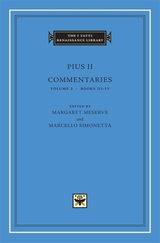 Commentaries
Pius IIEdited by Margaret Meserve and Marcello Simonetta
Harvard University Press The Renaissance popes were among the most enlightened and generous patrons of arts and letters in the Europe of their day. The diaries of Pius II give us an intimate glimpse of the life and thought of one of the greatest of the Renaissance popes. Pius II (1405-1464) began life as Aeneas Silvius Piccolomini in a small town near Siena and became a famous Latin poet and diplomat. Originally an opponent of the papacy as well as something of a libertine, Aeneas eventually reconciled himself with the Roman church and became a priest, then a cardinal. Finally he was elected Pope Pius II (1458) and dedicated his pontificate to organizing a pan-European crusade against the Ottoman Empire. Pius's Commentaries, the only autobiography ever written by a pope, was composed in elegant humanistic Latin modeled on Caesar and Cicero. This edition contains a fresh Latin text based on the last manuscript written in Pius's lifetime and an updated and corrected version of the 1937 translation by Florence Alden Gragg.
 Commentaries on Plato
Marsilio FicinoEdited and translated by Michael J. B. Allen
Harvard University Press, 2008 Marsilio Ficino (1433–1499), the Florentine scholar-philosopher-magus, was largely responsible for the Renaissance revival of Plato. The publication of his Latin translations of the dialogues in 1484 was an intellectual event of the first magnitude, making the Platonic canon accessible to western Europe after the passing of a millennium and establishing Plato as an authority for Renaissance thought.
This volume contains Ficino’s extended analysis and commentary on the Phaedrus, which he explicates as a meditation on “beauty in all its forms” and a sublime work of theology. In the commentary on the Ion, Ficino explores a poetics of divine inspiration that leads to the Neoplatonist portrayal of the soul as a rhapsode whose song is an ascent into the mind of God. Both works bear witness to Ficino’s attempt to revive a Christian Platonism and what might be called an Orphic Christianity.
Commentaries on Plato, Volume 2
Marsilio Ficino
Harvard University Press, 2008 Marsilio Ficino (1433–1499), the Florentine scholar-philosopher-magus, was largely responsible for the Renaissance revival of Plato. Ficino’s commentaries on Plato remained the standard guide to the Greek philosopher’s works for centuries. Vanhaelen’s new translation of Ficino’s vast commentary on the Parmenides makes this monument of Renaissance metaphysics accessible to the modern student of philosophy.
The volume contains the first critical edition of the Latin text, an ample introduction, and extensive notes.
Commentaries on Plato, Volume 2
Marsilio Ficino
Harvard University Press, 2008 Marsilio Ficino (1433–1499), the Florentine scholar-philosopher-magus, was largely responsible for the Renaissance revival of Plato. Ficino’s commentaries on Plato remained the standard guide to the Greek philosopher’s works for centuries. Vanhaelen’s new translation of Ficino’s vast commentary on the Parmenides makes this monument of Renaissance metaphysics accessible to the modern student of philosophy.
The volume contains the first critical edition of the Latin text, an ample introduction, and extensive notes.
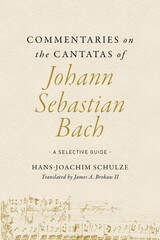 Commentaries on the Cantatas of Johann Sebastian Bach: A Selective Guide
Hans-Joachim Schulze. Translated by James A. Brokaw II
University of Illinois Press, 2024 Internationally recognized Bach authority Hans-Joachim Schulze authored a 225-part series on the cantatas of Johann Sebastian Bach. In this collection, James A. Brokaw II translates a selection of the essays, illuminating a wide range of biographical and cultural features of Bach’s life and creative milieu. Schulze’s lively and engaging discussions provide a wealth of rewarding insights and perspectives focusing on individual cantatas, their texts, and the questions of chronology and context that attend them. The University of Illinois Press has paired the volume with a special web-based companion overseen by the translator and hosted by the Illinois Open Publishing Network. This online resource includes Brokaw’s translations of all 225 of Schulze’s essays alongside digital tools for searching, sorting, and bundling the commentaries according to date of composition, position within the liturgical church year sequence, and librettist.
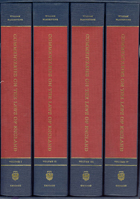 Commentaries on the Laws of England, A Facsimile of the First Edition of 1765-1769
William Blackstone
University of Chicago Press, 2002 Perhaps the most important legal treatise ever written in the English language, Sir William Blackstone's Commentaries on the Laws of England (1765-69) was the first effort to consolidate English common law into a unified and rational system. Clearly and elegantly written, the work achieved immediate renown and exerted a powerful influence on legal education both in England and America. This handsomely produced, slipcased four-volume set includes facsimiles of the eighteenth-century first edition, undistorted by later interpolations.
The Commentaries is divided into four books. The first, introduced by Stanley N. Katz, deals with what Blackstone called "the rights of persons," what a modern lawyer would call constitutional law, the legal structure of government. Book II includes an introduction by A. W. Brian Simpson and describes the law of property. Book III, introduced by John H. Langbein, analyzes civil procedure and remedies. The last book, which is devoted to criminal law and procedure, includes an introduction by Thomas A. Green.
Now regarded as a literary, as well as a legal classic, Blackstone's Commentaries brilliantly laid out the system of English law in the mid-eighteenth century, demonstrating that as a system of justice, it was comparable to Roman law and the civil law of the Continent. Ironically, the work also revealed to the colonists the insufficiencies of the system and became a model for the legal system of the fledgling American nation in 1789. Supplemented with commentary by experts in the field, these classic facsimile volumes belong on every lawyer's bookshelves.
Volume I: Of the Rights of Persons (1765)
Volume II: Of the Rights of Things (1766)
Volume III: Of Private Wrongs (1768)
Volume IV: Of Public Wrongs (1769)
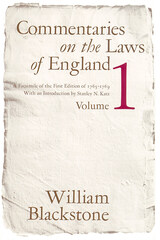 Commentaries on the Laws of England, Volume 1: A Facsimile of the First Edition of 1765-1769
William Blackstone
University of Chicago Press, 1979 Sir William Blackstone's Commentaries on the Laws of England (1765-1769) stands as the first great effort to reduce the English common law to a unified and rational system. Blackstone demonstrated that the English law as a system of justice was comparable to Roman law and the civil law of the Continent. Clearly and elegantly written, the work achieved immediate renown and exerted a powerful influence on legal education in England and in America which was to last into the late nineteenth century. The book is regarded not only as a legal classic but as a literary masterpiece.
Previously available only in an expensive hardcover set, Commentaries on the Laws of England is published here in four separate volumes, each one affordably priced in a paperback edition. These works are facsimiles of the eighteenth-century first edition and are undistorted by later interpolations. Each volume deals with a particular field of law and carries with it an introduction by a leading contemporary scholar.
In his introduction to this first volume, Of the Rights of Persons, Stanley N. Katz presents a brief history of Blackstone's academic and legal career and his purposes in writing the Commentaries. Katz discusses Blackstone's treatment of the structure of the English legal system, his attempts to justify it as the best form of government, and some of the problems he encountered in doing so.
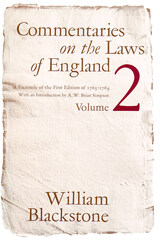 Commentaries on the Laws of England, Volume 2: A Facsimile of the First Edition of 1765-1769
William Blackstone
University of Chicago Press, 1979 Sir William Blackstone's Commentaries on the Laws of England (1765-1769) stands as the first great effort to reduce the English common law to a unified and rational system. Blackstone demonstrated that the English law as a system of justice was comparable to Roman law and the civil law of the Continent. Clearly and elegantly written, the work achieved immediate renown and exerted a powerful influence on legal education in England and in America which was to last into the late nineteenth century. The book is regarded not only as a legal classic but as a literary masterpiece.
Previously available only in an expensive hardcover set, Commentaries on the Laws of England is published here in four separate volumes, each one affordably priced in a paperback edition. These works are facsimiles of the eighteenth-century first edition and are undistorted by later interpolations. Each volume deals with a particular field of law and carries with it an introduction by a leading contemporary scholar.
Introducing this second volume, Of the Rights of Things, A. W. Brian Simpson discusses the history of Blackstone's theory of various aspects of property rights—real property, feudalism, estates, titles, personal property, and contracts—and the work of his predecessors.
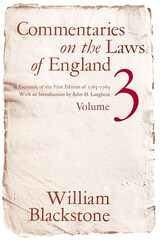 Commentaries on the Laws of England, Volume 3: A Facsimile of the First Edition of 1765-1769
William Blackstone
University of Chicago Press, 1979 Sir William Blackstone's Commentaries on the Laws of England (1765-1769) stands as the first great effort to reduce the English common law to a unified and rational system. Blackstone demonstrated that the English law as a system of justice was comparable to Roman law and the civil law of the Continent. Clearly and elegantly written, the work achieved immediate renown and exerted a powerful influence on legal education in England and in America which was to last into the late nineteenth century. The book is regarded not only as a legal classic but as a literary masterpiece.
Previously available only in an expensive hardcover set, Commentaries on the Laws of England is published here in four separate volumes, each one affordably priced in a paperback edition. These works are facsimiles of the eighteenth-century first edition and are undistorted by later interpolations. Each volume deals with a particular field of law and carries with it an introduction by a leading contemporary scholar.
Introducing this third volume, Of Private Wrongs, John H. Langbein discusses Blackstone's account of procedure and jurisdiction, jury trial, and equity. He also examines Blackstone's uneasy attitude toward the celebrated legal frictions of English civil procedure.
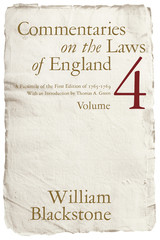 Commentaries on the Laws of England, Volume 4: A Facsimile of the First Edition of 1765-1769
William Blackstone
University of Chicago Press, 1979 Sir William Blackstone's Commentaries on the Laws of England (1765-1769) stands as the first great effort to reduce the English common law to a unified and rational system. Blackstone demonstrated that the English law as a system of justice was comparable to Roman law and the civil law of the Continent. Clearly and elegantly written, the work achieved immediate renown and exerted a powerful influence on legal education in England and in America which was to last into the late nineteenth century. The book is regarded not only as a legal classic but as a literary masterpiece.
Previously available only in an expensive hardcover set, Commentaries on the Laws of England is published here in four separate volumes, each one affordably priced in a paperback edition. These works are facsimiles of the eighteenth-century first edition and are undistorted by later interpolations. Each volume deals with a particular field of law and carries with it an introduction by a leading contemporary scholar.
Introducing this fourth and final volume, Of Public Wrongs, Thomas A. Green examines Blackstone's attempt to rationalize the severity of the law with what he saw as the essentially humane inspiration of English law. Green discusses Blackstone's ideas on criminal law, criminal procedure, and sentencing.
 Commentary and Ideology: Dante in the Renaissance
Deborah Parker
Duke University Press, 1993 Dante's Divine Comedy played a dual role in its relation to Italian Renaissance culture, actively shaping the fabric of that culture and, at the same time, being shaped by it. This productive relationship is examined in Commentary and Ideology, Deborah Parker's thorough compendium on the reception of Dante's chief work. By studying the social and historical circumstances under which commentaries on Dante were produced, the author clarifies the critical tradition of commentary and explains the ways in which this important body of material can be used in interpreting Dante's poem.
Parker begins by tracing the criticism of Dante commentaries from the nineteenth century to the present and then examines the tradition of commentary from the Middle Ages to the Renaissance. She shows how the civic, institutional, and social commitments of commentators shaped their response to the Comedy, and how commentators tried to use the poem as an authoritative source for various kinds of social legitimation. Parker discusses how different commentators dealt with a deeply political section of the poem: the damnation of Brutus and Cassius.
The scope and importance of Commentary and Ideology will command the attention of a broad group of scholars, including Italian specialists on Dante, late medievalists, students and professionals in early modern European literature, bibliographers, critical theorists, historians of literary criticism and theory, and cultural and intellectual historians.
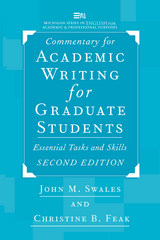 Commentary for Academic Writing for Graduate Students, 2d ed.: Essential Tasks and Skills
John M. Swales and Christine B. Feak
University of Michigan Press, 2004 The second edition of this successful guide to writing for graduate-and undergraduate-students has been modified to include updates and replacements of older data sets; an increased range of disciplines with tasks such as nursing, marketing, and art history; discussions of discourse analysis; a broader discussion of e-mail use that includes current e-mail practices.
Like its predecessor, this edition of Academic Writing for Graduate Students
"explains understanding the intended audience, the purpose of the paper, and academic genres.
"includes the use of task-based methodology, analytic group discussion, and genre consciousness-raising.
"shows how to write summaries and critiques.
"features "language focus" sections that address linguistic elements as they affect the wider rhetorical objectives.
"helps students position themselves as junior scholars in their academic communities.
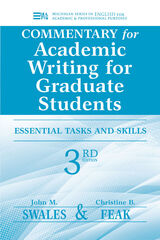 Commentary for Academic Writing for Graduate Students, 3rd Ed.: Essential Tasks and Skills
John M. Swales & Christine B. Feak
University of Michigan Press, 2012 The Commentary for the third edition of this successful guide to writing has been revised and expanded in many ways to provide more support for instructors; this includes additional tasks for Units Two and Four to supplement the main text. However, the collegial tone established in previous Commentaries between Swales & Feak and instructors has been retained. This volume contains commentaries on each of the eight units plus the two appendixes. The format for each unit includes - a summary of the main points of the unit along with a list of topics covered.
- a synopsis of activities, divided into Language Focus sections and description of tasks.
- some general notes designed to capture the character of the unit, to indicate alternative activities, or to anticipate problems that may arise.
- detailed commentary and discussion of individual tasks, including model or sample answers where possible.
Commentary In American Life
edited by Murray Friedman
Temple University Press, 2005 Founded by the American Jewish Committee in 1945 as a monthly journal of "significant thought and opinion, Jewish affairs and contemporary issues," Commentary magazine has through the years had a far-reaching impact on American politics and culture. Commentary in American Life traces this influence over time, especially in creating the neoconservative movement. The authors of each chapter also consider the ways the magazine shaped and reflected major cultural and literary trends in the United States. The end result offers a full accounting of one of the most important journals of American political thought, providing insight into the development of American collective politics and culture over the last six decades.
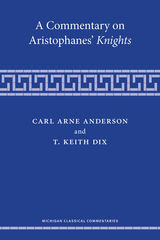 A Commentary on Aristophanes' Knights
Carl Arne Anderson and T. Keith Dix
University of Michigan Press, 2020 A Commentary on Aristophanes’ Knights presents a fresh look at the play that cemented Aristophanes’ reputation as a rising star in comic theater. Knights offers an examination of social and political life in ancient Athens during the empire-destroying Peloponnesian War, as well as giving us Aristophanes’ comic send-up of the dangerous populist demagogue Cleon. This is a thoroughly modern commentary on a key play in the theatrical genre of Old Comedy, which satirized virtually every aspect of Athenian life in a period when Athens was at the height of its power and international prestige. In addition to the complete Greek text and commentary, this volume includes a substantial introduction to the playwright’s career and to the historical and political background of the play. It includes advice for students on grammar and syntax, meter, festivals and staging, as well as topical and literary references and allusions that will help guide students to a mature appreciation of the comedy’s humor, seriousness, and artistic quality. Priced and sized for classroom use, this is the first full commentary on Knights since 1901 and will be widely welcomed.
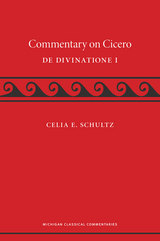 A Commentary on Cicero, De Divinatione I
Celia E. Schultz
University of Michigan Press, 2014 A Commentary on Cicero, De Divinatione I, is the first English-language commentary on the Latin text of Marcus Tullius Cicero’s dialogue in almost one hundred years. The defense of divination (the science of predicting the future) offered in Book 1 is illustrated with many entertaining anecdotes that make the argument more accessible to a wider range of readers than many of Cicero’s other philosophical works. De Divinatione also preserves many fragments of otherwise lost masterpieces of Roman Republican literature. It is a text important for the study of Roman religion, as well as Roman political and intellectual history. This commentary aims to assist the reader in seeing De Divinatione as a cohesive whole, and to make it accessible—not only to classicists, but also to scholars of religion and to philosophers who may not be familiar with the historical and Roman intellectual background that are the focus here. The cases made for and against divination in De Divinatione closely follow arguments made by Greek philosophers, but many of the examples illustrating them reflect Cicero’s preferences in literature, his own poetic efforts and political experience, and his expertise as an augur. The result is a very personal work closely tied to Cicero’s own experience. Celia Schultz’s volume contains the full Latin text of De Divinatione, Book 1, and accompanies it with commentary on points of grammar, history, prosopography, and ancient religious practice, among other topics. She includes a helpful bibliography for those interested in further study of points raised in the text or commentary.
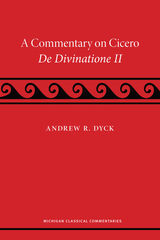 A Commentary on Cicero, De Divinatione II
Andrew R. Dyck
University of Michigan Press, 2020 Andrew R. Dyck ranks among the top Latinists in Ciceronian studies. In this new volume, he offers the first commentary on Cicero’s De Divinatione II in nearly a century. This commentary aims to equip students and scholars of Latin with the kinds of historical and philosophical background and linguistic and stylistic information needed to understand and appreciate Cicero’s text on Roman religion and divination. Dyck situates Cicero’s text in the context of Roman religion in antiquity, and he traces the subsequent reception of the text. The introduction reviews recent interpretations of De Divinatione. Dyck rejects the view that has recently been widespread in Anglophone studies that De Divinatione stages a debate between roughly equal opponents and without the emergence of a clear authorial point of view. Instead he argues that a careful reading shows that Cicero as author is invested in the argument, with the particular aim of countering superstition.
Celia Schultz’s earlier volume in this series presented the text and commentary for De Divinatione I. With Andrew Dyck’s companion volume on the second book of De Divinatione, students and teachers are well served with crucial texts from one of Rome’s most famous philosophers, as he considers important Roman practices and beliefs.
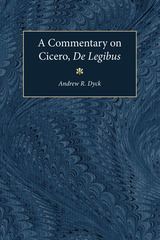 A Commentary on Cicero, De Legibus
Andrew R. Dyck
University of Michigan Press, 2004 Just as Plato drafted a vision of an ideal state in his Republic and followed that up with detailed provisions in his Laws, so Cicero -- after writing a Republic -- wanted to provide legislation for his ideal state and wrote de Legibus (the Laws) as a sequel. But while Cicero's Republic was set shortly before the death of its speaker, Scipio Africanus, in 129 b.c., his de Legibus was set in his own lifetime, thus enabling him to comment on current political events and trends. Written in the final years of the Roman Republic, de Legibus is as a work that gives Cicero's own diagnosis of the ills that had befallen the Roman state and what might be done to cure them. It is thus a document crucial to our understanding of one of the most turbulent periods of Roman history.
Surprisingly, de Legibus has been one of Cicero's most neglected works. Andrew R. Dyck's commentary is the first to appear on the complete work in well over one hundred years. Dyck provides a detailed interpretation and sets the essay into the context of the politics and philosophical thought of its time. While previous commentaries focused primarily on grammar and textual criticism, this one also seeks to relate Cicero's text to the political, philosophical, and religious trends of his day. The author identifies the influences on Cicero's thinking and analyzes the relation of this theoretical treatise to his other works. This commentary is based on a new text, worked out in consultations between the author and Jonathan Powell of Royal Holloway, London.
Andrew Dyck is Professor of Classics, University of California at Los Angeles.
A Commentary on Cicero, De Natura Deorum II
Andrew R. Dyck
University of Michigan Press, 2025 Distinguished Latinist Andrew R. Dyck presents the first English commentary on Cicero’s De Natura Deorum II in over fifty years. This text is the only connected exposition of Stoic theology to survive from the ancient world. It includes an argument for the existence of the gods from the construction of the cosmos taken up by later thinkers, as well as an exposition of the world-order and divine providence according to Stoic doctrine. After a period in which Cicero’s philosophical works were treated mainly as sources for reconstructing the thought of earlier philosophers, they are now coming to be appreciated as intelligent and skillful works in their own right. This book will assist students and others studying Cicero’s De Natura Deorum II by providing its historical context, improved Latin text, and a detailed commentary with references to the latest literature on the subject.
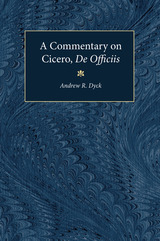 A Commentary on Cicero, De Officiis
Andrew R. Dyck
University of Michigan Press, 1997 Toward the end of the last century Cicero's work came under attack from several angles. His political stance was sharply criticized for inconsistency by Theodor Mommsen and others, his philosophical works for lack of originality. Since then scholars have come to a better understanding of the political conditions that informed the views of Mommsen and his contemporaries about Caesar and Cicero, and as a result Cicero's writings have been restored to a more appropriate position in the literature and history of the Roman Republic. At the same time recent years have seen an intensive study of Hellenistic philosophy, and this has shown more clearly than before that, even while following Greek models, Cicero nonetheless pursued his own political and, in the ethical works, moralistic agenda.
Composed in haste shortly before Cicero's death, de Officiis has exercised enormous influence over the centuries. It is all the more surprising that Andrew R. Dyck's volume is the first detailed English commentary on the work written in this century. It deals with the problems of the Latin text (taking account of Michael Winterbottom's new edition), it delineates the work's structure and sometimes elusive train of thought, clarifies the underlying Greek and Latin concepts, and provides starting points for approaching the philosophical and historical problems that de Officiis raises.
A work of major importance for classicists, philosophers, and ancient historians, this Commentary will be an invaluable companion to all readers of Cicero's last philosophical work.
Andrew R. Dyck is Professor of Classics, University of California, Los Angeles.
Publication of this volume is supported by a grant from the National Endowment for the Humanities.
Commentary on Galatians
Jerome
Catholic University of America Press, 2011 Jerome's Commentary on Galatians is presented here in English translation in its entirety.
Commentary on Genesis
Didymus the Blind
Catholic University of America Press, 2016 Blind since early childhood, the Egyptian theologian and monk Didymus (ca. 313-398) wielded a masterful knowledge of Scripture, philosophy, and previous biblical interpretation, earning the esteem of his contemporaries Athanasius, Antony of Egypt, Jerome, Rufinus, and Palladius, as well as of the historians Socrates and Theodoret in the decades following his death. He was, however, anathematized by the Fifth Ecumenical Council in 553 because of his utilization and defense of the works of Origen, and this condemnation may be responsible for the loss of many of Didymus's writings. Jerome and Palladius mentioned that Didymus had written commentaries on Old Testament books; these commentaries were assumed to be no longer extant until the discovery in 1941 in Tura, Egypt, of papyri containing commentaries on Genesis, Zechariah, Job, Ecclesiastes, and some of the Psalms.
A Commentary on Heidegger's Being and Time, Revised Edition
Michael Gelven
Northern Illinois University Press, 1989
This thoroughly revised commentary uses the most recent insights in Heidegger studies to lead the reader through the sometimes difficult text of Being and Time. The clearly marked section-by-section analysis explains the structure of Being and Time, illuminates obscure passages, and presents examples of human experience to elucidate Heidegger's points. So that the reader does not lose sight of the main argument, Gelven summarizes the relevant concepts of Heidegger's chapters prior to his explicit interpretation of each section. Even though Gelven's commentary is primarily intended to be used as a supplement to Being and Time, the text also serves as an articulate study in Heideggerian philosophy.
 A Commentary on The Old English and Anglo-Latin Riddle Tradition
Andy Orchard
Harvard University Press, 2021 This volume is a companion to The Old English and Anglo-Latin Riddle Tradition. Its extensive notes and commentary on hundreds of Latin, Old English, and Old Norse–Icelandic riddles illuminate and clarify the multifaceted and interconnected nature of a broad, international tradition. Within this commentary, readers will encounter a deep reservoir of knowledge about riddles produced in both Latin and Old English during the Anglo-Saxon period, and the literatures with which they were in dialogue.
Riddles range from those by prominent authors like Aldhelm, Bede, Alcuin, and Boniface to those presented anonymously in collections such as the Exeter Book. All are fully discussed, with particular attention paid to manuscript traditions, subject matter, solutions, style, sources, parallels, and recommendations for further reading. Consideration is given to running themes throughout the collection, comparisons to other riddles and to other literature more broadly, and important linguistic observations and manuscript readings. The commentary also lists the manuscripts and earlier editions for each riddle, extensive catalogues of proposed solutions, and additional bibliographic references. Following the general discussion of each riddle there is detailed line-by-line annotation.
This authoritative commentary is the most comprehensive examination to date of the bilingual riddle tradition of Anglo-Saxon England and its links to the wider world.
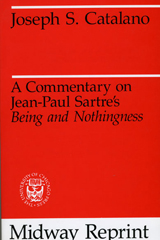 A Commentary on Jean-Paul Sartre's Being and Nothingness
Joseph S. Catalano
University of Chicago Press, 1985 "[A Commentary on Jean-Paul Sartre's Being and Nothingness] represents, I believe, a very important beginning of a deservingly serious effort to make the whole of Being and Nothingness more readily understandable and readable. . . . In his systematic interpretations of Sartre's book, [Catalano] demonstrates a determination to confront many of the most demanding issues and concepts of Being and Nothingness. He does not shrink—as do so many interpreters of Sartre—from such issues as the varied meanings of 'being,' the meaning of 'internal negation' and 'absolute event,' the idiosyncratic senses of transcendence, the meaning of the 'upsurge' in its different contexts, what it means to say that we 'exist our body,' the connotation of such concepts as quality, quantity, potentiality, and instrumentality (in respect to Sartre's world of 'things'), or the origin of negation. . . . Catalano offers what is doubtless one of the most probing, original, and illuminating interpretations of Sartre's crucial concept of nothingness to appear in the Sartrean literature."—Ronald E. Santoni, International Philosophical Quarterly
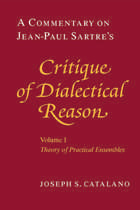 A Commentary on Jean-Paul Sartre's Critique of Dialectical Reason, Volume 1, Theory of Practical Ensembles
Joseph S. Catalano
University of Chicago Press, 1986 Sartre’s Critique of Dialectical Reason ranks with Being and Nothingness as a work of major philosophical significance, but it has been largely neglected. The first volume, published in 1960, was dismissed as a Marxist work at a time when structuralism was coming into vogue; the incomplete second volume has only recently been published in France. In this commentary on the first volume, Joseph S. Catalano restores the Critique to its deserved place among Sartre’s works and within philosophical discourse as a whole. Sartre attempts one of the most needed tasks of our times, Catalano asserts—the delivery of history into the hands of the average person. Sartre’s concern in the Critique is with the historical significance of everyday life. Can we, he asks, as individuals or even collectively, direct the course of our history? A historical context for our lives is given to us at birth, but we sustain that context with even our most mundane actions—buying a newspaper, waiting in line, eating a meal. In looking at history, Sartre argues, reason can never separate the historical situation of the investigator from the investigation. Thus reason falls into a dialectic, always depending upon the past for guidance but always being reshaped by the present. Clearly showing the influence of Marx on Sartre’s thought, the Critique adds the historical dimension lacking in Being and Nothingness. In placing the Critique within the corpus of Sartre’s philosophical writings, Catalano argues that it represents a development rather than a break from Sartre’s existentialist phase. Catalano has organized his commentary to follow the Critique and has supplied clear examples and concrete expositions of the most difficult ideas. He explicates the dialogue between Marx and Sartre that is internal to the text, and he also discusses Sartre’s Search for Method, which is published separately from the Critique in English editions.
A Commentary on Kant's Critique of Practical Reason
Lewis White Beck
University of Chicago Press, 1996 When this work was first published in 1960, it immediately filled a void in Kantian scholarship. It was the first study entirely devoted to Kant's Critique of Practical Reason and by far the most substantial commentary on it ever written. This landmark in Western philosophical literature remains an indispensable aid to a complete understanding of Kant's philosophy for students and scholars alike.
This Critique is the only writing in which Kant weaves his thoughts on practical reason into a unified argument. Lewis White Beck offers a classic examination of this argument and expertly places it in the context of Kant's philosophy and of the moral philosophy of the eighteenth century.
Commentary on Matthew
Saint Jerome
Catholic University of America Press, 2008 His Commentary on Matthew, written in 398 and profoundly influential in the West, appears here for the first time in English translation. Jerome covers the entire text of Matthew's gospel by means of brief explanatory comments that clarify the text literally and historically.
Commentary on Matthew
St. Hilary of Poiters
Catholic University of America Press, 2012 St. Jerome (347-420) has been considered the pre-eminent scriptural commentator among the Latin Church Fathers. His Commentary on Matthew, written in 398 and profoundly influential in the West, appears here for the first time in English translation.
 A Commentary on Nigel of Canterbury’s Miracles of the Virgin
Jan M. Ziolkowski
Harvard University Press Nigel of Canterbury, also known as Longchamp and Whiteacre, wrote toward the end of the so-called Twelfth-Century Renaissance. He was a Benedictine monk of Christ Church when Thomas Becket was martyred, and a star of Anglo-Latin literature while the Angevin kings held sway over a vast empire that encompassed not only the British Isles but also western France.
The Dumbarton Oaks Medieval Library volume features, alongside the Latin, the first-ever English translation of Nigel’s second-longest poem, Miracles of the Virgin. The Miracles is the oldest extant collection of versified miracles of Mary in Latin and indeed in any language. The seventeen narratives, telling a gamut of tales from diabolic pacts to pregnant abbesses, gave scope for Nigel to display skills as a storyteller and stylist, while recounting the miraculous mercy of the Virgin. This supplement offers an extensive commentary to facilitate appreciation of the Miracles as poetry by a medieval writer deeply imbued in the long tradition of Latin literature.
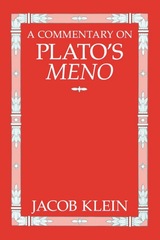 A Commentary on Plato's Meno
Jacob Klein
University of Chicago Press, 1989 The Meno, one of the most widely read of the Platonic dialogues, is seen afresh in this original interpretation that explores the dialogue as a theatrical presentation. Just as Socrates's listeners would have questioned and examined their own thinking in response to the presentation, so, Klein shows, should modern readers become involved in the drama of the dialogue. Klein offers a line-by-line commentary on the text of the Meno itself that animates the characters and conversation and carefully probes each significant turn of the argument.
"A major addition to the literature on the Meno and necessary reading for every student of the dialogue."—Alexander Seasonske, Philosophical Review
"There exists no other commentary on Meno which is so thorough, sound, and enlightening."—Choice
Jacob Klein (1899-1978) was a student of Martin Heidegger and a tutor at St. John's College from 1937 until his death. His other works include Plato's Trilogy: Theaetetus, the Sophist, and the Statesman, also published by the University of Chicago Press.
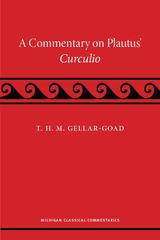 A Commentary on Plautus' Curculio
T. H. M. Gellar-Goad
University of Michigan Press, 2024 Lively and critically aware, T. H. M. Gellar-Goad’s A Commentary on Plautus’ Curculio is the new reference text on the play. Curculio follows the efforts of the title character to trick a sex-trafficker into handing over an enslaved woman to the young man infatuated with her instead of to the soldier who’s paid for her—and will turn out to be her long-lost brother. As Plautus’ shortest comedy, Curculio has proven to be a desirable text for university performances. The play exemplifies Plautus’ style, with a blend of erotic, deception, and recognition plotlines, plus a wide range of archetypal characters. Gellar-Goad’s commentary is the complete package, with introductions to themes, content, humor, meter, and syntax; notes on matters of performance, interpretation, and social history; and a text with aids to scansion and clarifying stage directions.
This up-to-date, authoritative commentary on the play will prove useful to directors and actors and will readily introduce students to the joys of Roman comedy.
Commentary on Plotinus
Marsilio Ficino
Harvard University Press, 2017 Marsilio Ficino (1433–1499) was the leading Platonic philosopher of the Renaissance and is generally recognized as the greatest authority on ancient Platonism before modern times. Among his finest accomplishments as a scholar was his 1492 Latin translation of the complete works of Plotinus (204–270 CE), the founder of Neoplatonism. The 1492 edition also contained an immense commentary that remained for centuries the principle introduction to Plotinus’s works for Western scholars. At the same time, it constitutes a major statement of Ficino’s own late metaphysics. The I Tatti edition, planned in six volumes, contains the first modern edition of the Latin text and the first translation into any modern language. The present volume also includes a substantial analytical study of Ficino’s interpretation of Plotinus’ Fourth Ennead.
Commentary on Plotinus
Marsilio Ficino
Harvard University Press, 2017 Marsilio Ficino (1433–1499) was the leading Platonic philosopher of the Renaissance and is generally recognized as the greatest authority on ancient Platonism before modern times. Among his greatest accomplishments as a scholar was his 1492 Latin translation of the complete works of Plotinus (204–270 CE), the founder of Neoplatonism. The 1492 edition also contained an immense commentary that remained for centuries the principle introduction to Plotinus’s works for Western scholars. At the same time, it constitutes a major statement of Ficino’s own late metaphysics. The I Tatti edition, planned in six volumes, contains the first modern edition of the Latin text and the first translation into any modern language. The present volume also contains an extensive analytical study of Ficino’s interpretation of Plotinus’s Third Ennead.
Commentary on Plotinus
Marsilio Ficino
Harvard University Press A preeminent Renaissance philosopher on the founder of Neoplatonism
Marsilio Ficino (1433–1499) was the leading Platonic philosopher of the Renaissance and is generally recognized as the greatest authority on ancient Platonism before modern times. Among his greatest accomplishments as a scholar was his 1492 Latin translation of the complete works of Plotinus (204–270 CE), the founder of Neoplatonism. The 1492 edition also contained an immense commentary that remained for centuries the principle introduction to Plotinus’s works for Western scholars. At the same time, it constitutes a major statement of Ficino’s own late metaphysics. The I Tatti edition, planned in six volumes, contains the first modern edition of the Latin text and the first translation into any modern language. The present volume also contains a summary of Ficino’s argumentation in the commentary on Plotinus’ First Ennead.
Commentary on the Apocalypse
Andrew of Caesarea
Catholic University of America Press, 2012 Striking a balance between the symbolic language of the book and its literal, prophetic fulfillment, Andrew?s interpretation is a remarkably intelligent, spiritual, and thoughtful commentary that encourages the pursuit of virtue and confidence in the love of God for humanity
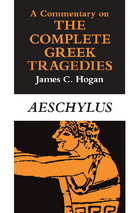 A Commentary on The Complete Greek Tragedies. Aeschylus
James C. Hogan
University of Chicago Press, 1985 This commentary offers a rich introduction and useful guide to the seven surviving plays attributed to Aeschylus. Though it may profitably be used with any translation of Aeschylus, the commentary is based on the acclaimed Chicago translations, The Complete Greek Tragedies, edited by David Grene and Richmond Lattimore.
James C. Hogan provides a general introduction to Aeschylean theater and drama, followed by a line-by-line commentary on each of the seven plays. He places Aeschylus in the historical, cultural, and religious context of fifth-century Athens, showing how the action and metaphor of Aeschylean theater can be illuminated by information on Athenian law athletic contests, relations with neighboring states, beliefs about the underworld, and countless other details of Hellenic life. Hogan clarifies terms that might puzzle modern readers, such as place names and mythological references, and gives special attention to textual and linguistic issues: controversial questions of interpretation; difficult or significant Greek words; use of style, rhetoric, and commonplaces in Greek poetry; and Aeschylus's place in the poetic tradition of Homer, Hesiod, and the elegiac poets. Practical information on staging and production is also included, as are maps and illustrations, a bibliography, indexes, and extensive cross-references between the seven plays. Forthcoming volumes will cover the works of Sophocles and Euripides.
Commentary on the Epistle to the Romans
Peter Abelard
Catholic University of America Press, 2011 Despite its importance and the frequent references made to it by modern scholars, this commentary has never before been translated into English in its entirety. This volume, which includes an extensive introduction, fills this gap, thus providing a needed contribution to medieval scholarship.
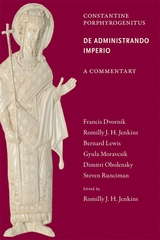 Commentary on the De Administrando Imperio
R. J. H. Jenkins
Harvard University Press, 2012 The De Administrando Imperio, compiled by Constantine VII Porphyrogenitus in the tenth century, is one of the most important historical documents surviving from the middle Byzantine period, containing a wide variety of information on foreign relations and internal administration. The critical text of the De Administrando Imperio, edited by Gyula Moravcsik and translated by R. J. H. Jenkins (Dumbarton Oaks Texts), is now joined by the commentary, written in 1962 by a team of eminent scholars led by Jenkins. Long out of print, the Jenkins commentary remains the most thorough and authoritative study of this significant medieval text, and it is now republished as a companion volume to the critical text and translation. In addition to extensive commentary on the historical, geographical, and philological nuances of the Greek text, this volume contains a bibliography, map, indexes, and genealogical charts.
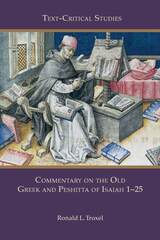 Commentary on the Old Greek and Peshitta of Isaiah 1–25
Ronald L. Troxel
SBL Press, 2020 The first thorough commentary on the Old Greek and Peshitta of Isaiah
Ronald L. Troxel’s new textual commentary on Isaiah focuses on the book’s Greek and Syriac translations and seeks to recover, as much as possible, the Hebrew texts on which these early translations relied. Troxel treats the Greek and Syriac together in order to present a detailed analysis of their relationship, devoting particular attention to whether the Syriac was directly or indirectly influenced by the Greek. This comparison sheds light on both the shared and distinct approaches that the translators took in rendering lexemes, phrases, verses, and even passages. In addition Troxel presents observations about the literary structures the translators created that differ from those implicit in their source texts (as we understand them), to produce coherent discourse in the target language.
Features:
- Textual commentary on the life of the text of Isaiah 1–25
- Use of the Dead Sea Scrolls to shed light on particular issues
- Detailed comparison of the Masoretic Text, the Old Greek, and the Peshitta
A Commentary on the Plays of Sophocles
James C. Hogan
Southern Illinois University Press, 1991
James C. Hogan introduces each play by highlighting specific and interpretive problems relevant to that play before turning to a line-by-line analysis. The line analysis is comprehensive, ranging from the meanings of words and phrases that pertain to a variety of Greek ideas and institutions to metaphor and imagery specific to each play as well as plots and borrowings from earlier poetry, styles, and characterizations.
Along with his examination of the seven extant plays of Sophocles in English translations, Hogan provides a general introduction to the theatre in Sophocles’ time, discussing staging, the conventions of the Greek theatre, the text of the plays, and mythology and religion.
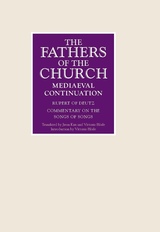 Commentary on the Songs of Songs
Rupert of Deutz
Catholic University of America Press, 2024 This is the first English translation of a major work by Rupert of Deutz, arguably the most prolific Christian author since Augustine. During his lifetime, which spanned the eleventh and twelfth centuries, Rupert engaged in controversies on the Eucharist and on predestination and composed works on the Trinity, salvation in Christ, and other major theological topics. An ardent defender of a monastic theology that focused on the interpretation of Scripture and the liturgy, Rupert is well known also for his distinctive hermeneutical approach to the Bible. His Commentary on the Songs of Songs builds on the long Hebrew-Christian tradition of allegorical interpretation of this Old Testament book but adds a radically original dimension to it: it interprets the text as a dialogue between Jesus and Mary and unfolds in this context a novel approach to Mary, who is presented as the teacher of the apostles and assumed to have participated in the Apostolic Council, described in Acts 15.
Rupert has prefaced his commentary with a letter to Thietmar, bishop of Verden (in northern Germany), as well as a prologue in which he reflects on his experience of being called to perform this exegetical task. The complete translation by Jieon Kim and Vittorio Hösle of this major work (up to now translated only into German) is preceded by an introduction that discusses Rupert's life and works, as well as the history of the interpretation of the Song of Songs, and offers hermeneutical reflections on Rupert's methodology.
 Commentary on Thucydides, Book 3
Rachel Bruzzone
University of Michigan Press, 2025 Thucydides’ History of the Peloponnesian War is one of the most significant historical and political texts of Ancient Greece, enjoying a broad appeal among the educated general public since at least 1628. The past decade has seen the historian garner significant attention even in the popular press, as scholars and politicians alike have sought to employ the History to analyze current international relations. Despite this popularity, the complexity of Thucydides’ Greek has left the original language surprisingly challenging.
Commentary on Thucydides, Book 3 remedies this situation by offering detailed linguistic explanations and grammatical clarifications designed to appeal both to seasoned Classicists and to a broader group of non-specialist readers who may still be developing their Greek language skills. Starting with 428 BCE, Book 3 covers a critical period of the Peloponnesian War in which the conflict began to manifest its extraordinary violence and scale. The book contains influential and controversial discussions, including Thucydides’ own analysis of the nature of war and the ways that it teaches “lessons of violence” to individuals and states. Book 3 also features the famous Mytilenean Debate, an argument premised on the thesis that all international relations are, or should be, fundamentally amoral. Educated readers have always looked to Thucydides in turbulent times, and this commentary will open up his text to a wider audience.
Commentary on Zechariah
Didymus the Blind
Catholic University of America Press, 2006 A disciple of Origen, whose work on Zechariah reached only to chapter five and is no longer extant, Didymus's commentary on this apocalyptic book illustrates the typically allegorical approach to the biblical text that we associate with Alexandria
 A Commentary to Pushkin’s Lyric Poetry, 1826–1836
Michael Wachtel
University of Wisconsin Press, 2012 Alexander Pushkin’s lyric poetry—much of it known to Russians by heart—is the cornerstone of the Russian literary tradition, yet until now there has been no detailed commentary of it in any language.
Michael Wachtel’s book, designed for those who can read Russian comfortably but not natively, provides the historical, biographical, and cultural context needed to appreciate the work of Russia’s greatest poet. Each entry begins with a concise summary highlighting the key information about the poem’s origin, subtexts, and poetic form (meter, stanzaic structure, and rhyme scheme). In line-by-line fashion, Wachtel then elucidates aspects most likely to challenge non-native readers: archaic language, colloquialisms, and unusual diction or syntax. Where relevant, he addresses political, religious, and folkloric issues.
Pushkin’s verse has attracted generations of brilliant interpreters. The purpose of this commentary is not to offer a new interpretation, but to give sufficient linguistic and cultural contextualization to make informed interpretation possible.
 Commerce and Social Standing in Ancient Rome
John H. D'Arms
Harvard University Press, 1981 John D'Arms explores here a question of central importance for the social economic history of the Roman world: which sectors of society were actively engaged in trade?
In the late Roman Republic and early Empire senators were prohibited by law from direct participation in seaborne commerce; trade was not considered a respectable pursuit. Yet large fortunes were amassed by men of rank through a variety of lucrative enterprises. Exploiting the evidence of literature, archaeology, and inscription, D'Arms constructs case histories which reveal how senators realized commercial profits by indirect involvement: freedmen, municipal notables, and "friends" often served as the equivalent of partners or agents of aristocrats with large holdings in land. In demonstrating a flexibility in upper-class attitudes toward commercial activity, he offers a study in the adaptation of a social system to economic realities.
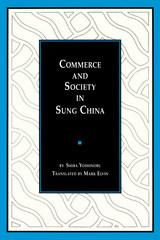 Commerce and Society in Sung China
Shiba Yoshinobu; Translated by Mark Elvin
University of Michigan Press, 1969 The full dimensions of the medieval Chinese economic revolution are still almost unknown to economic historians in the Western world, and the manifold problems that it raises for accepted theories of economic development have hardly begun to be systematically considered. Japanese scholars have been the pioneers in opening up this field, and Professor Shiba’s Commerce and Society in Sung China is among the most recent and most impressive fruits of their labors. For the first time it is possible to be relatively confident, as the result of the author’s systematic exploitation of an enormous range of source materials, about the parts played by transport, trade, business organization and urbanization in this revolution. It is hardly necessary to labor the significance of the advance. China’s was beyond any reasonable doubt the most developed economy in the medieval world, and the investigation both of the causes that made this possible and of those that subsequently prevented a take-off into sustained growth is among the most pressing tasks waiting to be accomplished before any general theory of economic development, solidly grounded in comparative historical analysis, becomes possible.
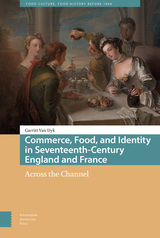 Commerce, Food, and Identity in Seventeenth-Century England and France: Across the Channel
Garritt van Dyk
Amsterdam University Press, 2022 “Tell me what you eat, and I’ll tell you who you are” was the challenge issued by French gastronomist Jean Brillat-Savarin. Champagne is declared a unique emblem of French sophistication and luxury, linked to the myth of its invention by Dom Pérignon. Across the Channel, a cup of sweet tea is recognized as a quintessentially English icon, simultaneously conjuring images of empire, civility, and relentless rain that demands the sustenance and comfort that only tea can provide. How did these tastes develop in the seventeenth century?
Commerce, Food, and Identity in Seventeenth-Century England and France: Across the Channel offers a compelling historical narrative of the relationship between food, national identity, and political economy in the early modern period. These mutually influential relationships are revealed through comparative and transnational analyses of effervescent wine, spices and cookbooks, the development of coffeehouses and cafés, and the ‘national sweet tooth’ in England and France.
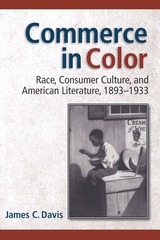 Commerce in Color: Race, Consumer Culture, and American Literature, 1893-1933
James C. Davis
University of Michigan Press, 2010 Commerce in Color exploresthe juncture of consumer culture and race by examining advertising, literary texts, mass culture, and public events in the United States from 1893 to 1933. James C. Davis takes up a remarkable range of subjects—including the crucial role publishers Boni and Liveright played in the marketing of Harlem Renaissance literature, Henry James’s critique of materialism in The American Scene, and the commodification of racialized popular culture in James Weldon Johnson’s The Autobiography of anEx-Colored Man—as he argues that racial thinking was central to the emergence of U.S. consumerism and, conversely, that an emerging consumer culture was a key element in the development of racial thinking and the consolidation of racial identity in America. By urging a reassessment of the familiar rubrics of the “culture of consumption” and the “culture of segregation,” Dawson poses new and provocative questions about American culture and social history.
Both an influential literary study and an absorbing historical read, Commerce in Color proves that—in America—advertising, publicity, and the development of the modern economy cannot be understood apart from the question of race. “A welcome addition to existing scholarship, Davis’s study of the intersection of racial thinking and the emergence of consumer culture makes connections very few scholars have considered.” —James Smethurst, University of Massachusetts James C. Davis is Assistant Professor of English at Brooklyn College.
 Commerce in Culture: The Sibao Book Trade in the Qing and Republican Periods
Cynthia J. Brokaw
Harvard University Press, 2007 Sibao today is a cluster of impoverished villages in the mountains of western Fujian. Yet from the late seventeenth through the early twentieth century, it was home to a flourishing publishing industry. Through itinerant booksellers and branch bookshops managed by Sibao natives, this industry supplied much of south China with cheap educational texts, household guides, medical handbooks, and fortune-telling manuals.
It is precisely the ordinariness of Sibao imprints that make them valuable for the study of commercial publishing, the text-production process, and the geographical and social expansion of book culture in Chinese society. In a study with important implications for cultural and economic history, Cynthia Brokaw describes rural, lower-level publishing and bookselling operations at the end of the imperial period. Commerce in Culture traces how the poverty and isolation of Sibao necessitated a bare-bones approach to publishing and bookselling and how the Hakka identity of the Sibao publishers shaped the configuration of their distribution networks and even the nature of their publications.
Sibao's industry reveals two major trends in print culture: the geographical extension of commercial woodblock publishing to hinterlands previously untouched by commercial book culture and the related social penetration of texts to lower-status levels of the population.
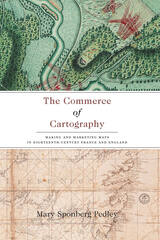 The Commerce of Cartography: Making and Marketing Maps in Eighteenth-Century France and England
Mary Sponberg Pedley
University of Chicago Press, 2005 Though the political and intellectual history of mapmaking in the eighteenth century is well established, the details of its commercial revolution have until now been widely scattered. In The Commerce of Cartography, Mary Pedley presents a vivid picture of the costs and profits of the mapmaking industry in England and France, and reveals how the economics of map trade affected the content and appearance of the maps themselves.
Conceptualizing the relationship between economics and cartography, Pedley traces the process of mapmaking from compilation, production, and marketing to consumption, reception, and criticism. In detailing the rise of commercial cartography, Pedley explores qualitative issues of mapmaking as well. Why, for instance, did eighteenth-century ideals of aesthetics override the modern values of accuracy and detail? And what, to an eighteenth-century mind and eye, qualified as a good map?
A thorough and engaging study of the business of cartography during the Enlightenment, The Commerce of Cartography charts a new cartographic landscape and will prove invaluable to scholars of economic history, historical geography, and the history of publishing.
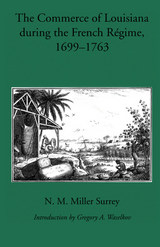 The Commerce of Louisiana During the French Regime, 1699-1763
N. M. Miller Surrey, with an introduction by Gregory A. Waselkov
University of Alabama Press, 2006 This volume reveals the wider scope of the French political and economic situation, as well as the minutiae of common barter and trade in Louisiana during the French Régime.
By the time French colonists sought a portion of the New World’s riches, much of those resources had already been claimed by Spain and Portugal. Once settled in North America, however, they quickly turned their attentions to commerce, specifically to trade within the Louisiana region. For almost 65 years French explorers, soldiers, administrators, and accountants focused on establishing a string of forts and small villages at key points in the Mississippi and Illinois River valleys, eastward to the Mobile River drainage, and westward toward New Mexico. Despite a long and costly war at home, for a time it looked as though the French would be successful in controlling a vast swath of the middle of North America with routes stretching from Quebec City to New Orleans.
Under the guidance of leaders such as LaSalle, Joliet, Father Marquette, Frontenac, Hennepin, and Bienville, the French made a good start in the lucrative trading business and established working relationships with most of the Indians of the region. But by 1763, with war in Europe and a faltering economy at home, commerce in the New World eroded along with the ability of the French to control the region and to protect their investments from the encroachment of the Spanish and English.
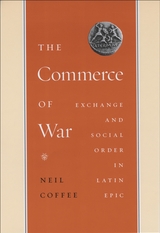 The Commerce of War: Exchange and Social Order in Latin Epic
Neil Coffee
University of Chicago Press, 2009 Latin epics such as Virgil’s Aeneid, Lucan’s Civil War, and Statius’s Thebaid addressed Roman aristocrats whose dealings in gifts, favors, and payments defined their conceptions of social order. In The Commerce of War, Neil Coffee argues that these exchanges play a central yet overlooked role in epic depictions of Roman society. Tracing the collapse of an aristocratic worldview across all three poems, Coffee highlights the distinction they draw between reciprocal gift giving among elites and the more problematic behaviors of buying and selling. In the Aeneid, customary gift and favor exchanges are undermined by characters who view human interaction as short-term and commodity-driven. The Civil War takes the next logical step, illuminating how Romans cope once commercial greed has supplanted traditional values. Concluding with the Thebaid, which focuses on the problems of excessive consumption rather than exchange, Coffee closes his powerful case that these poems constitute far-reaching critiques of Roman society during its transition from republic to empire.
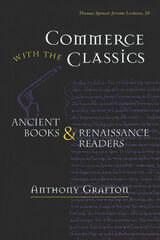 Commerce with the Classics: Ancient Books and Renaissance Readers
Anthony Grafton
University of Michigan Press, 1997 The style of reading in Renaissance Europe, as seen in the margins of books and in the texts of Renaissance intellectuals themselves, is deftly charted in this welcome volume from Anthony Grafton. Growing out of the Thomas Spencer Jerome Lectures that Anthony Grafton gave at the University of Michigan in 1992, this book describes the interaction between books and readers in the Renaissance, as seen in four major case studies. Humanists Alberti, Pico, Budé, and Kepler, all major figures of their time and now major figures in intellectual history, are examined in the light of their distinctive ways of reading. Investigating a period of two centuries, Grafton vividly portrays the ways in which book/scholar interactions--and the established traditions that were reflected in these interactions--were part of and helped shape the subjects' Humanistic philosophy. The book also indicates how these traditions have implications for the modern literary scene. Commerce with the Classics: Ancient Books and Renaissance Readers illustrates the immense variety of the humanist readers of the Renaissance. Grafton describes life in the Renaissance library, how the act of reading was shaped by the physical environment, and various styles of reading during the time. A strong sense of what skilled reading was like in the past is built up through anecdotes, philological analysis, and documents from a wide variety of sources, many of them unpublished. This volume will be of special interest to Renaissance and intellectual historians, students of Renaissance literature, and classicists who concern themselves with the afterlife of their texts. Anthony Grafton is Henry Putnam University Professor of History, Princeton University.
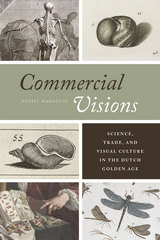 Commercial Visions: Science, Trade, and Visual Culture in the Dutch Golden Age
Dániel Margócsy
University of Chicago Press, 2014 Entrepreneurial science is not new; business interests have strongly influenced science since the Scientific Revolution. In Commercial Visions, Dániel Margócsy illustrates that product marketing, patent litigation, and even ghostwriting pervaded natural history and medicine—the “big sciences” of the early modern era—and argues that the growth of global trade during the Dutch Golden Age gave rise to an entrepreneurial network of transnational science.
Margócsy introduces a number of natural historians, physicians, and curiosi in Amsterdam, London, St. Petersburg, and Paris who, in their efforts to boost their trade, developed modern taxonomy, invented color printing and anatomical preparation techniques, and contributed to philosophical debates on topics ranging from human anatomy to Newtonian optics. These scientific practitioners, including Frederik Ruysch and Albertus Seba, were out to do business: they produced and sold exotic curiosities, anatomical prints, preserved specimens, and atlases of natural history to customers all around the world. Margócsy reveals how their entrepreneurial rivalries transformed the scholarly world of the Republic of Letters into a competitive marketplace.
Margócsy’s highly readable and engaging book will be warmly welcomed by anyone interested in early modern science, global trade, art, and culture.
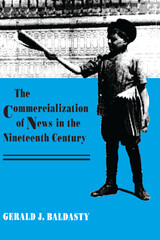 The Commercialization of News in the Nineteenth Century
Gerald J. Baldasty
University of Wisconsin Press, 1992 The Commercialization of News in the Nineteenth Century traces the major transformation of newspapers from a politically based press to a commercially based press in the nineteenth century. Gerald J. Baldasty argues that broad changes in American society, the national economy, and the newspaper industry brought about this dramatic shift.
Increasingly in the nineteenth century, news became a commodity valued more for its profitablility than for its role in informing or persuading the public on political issues. Newspapers started out as highly partisan adjuncts of political parties. As advertisers replaced political parties as the chief financial support of the press, they influenced newspapers in directing their content toward consumers, especially women. The results were recipes, fiction, contests, and features on everything from sports to fashion alongside more standard news about politics.
Baldasty makes use of nineteenth-century materials—newspapers from throughout the era, manuscript letters from journalists and politicians, journalism and advertising trade publications, government reports—to document the changing role of the press during the period. He identifies three important phases: the partisan newspapers of the Jacksonian era (1825-1835), the transition of the press in the middle of the century, and the influence of commercialization of the news in the last two decades of the century.
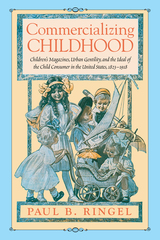 Commercializing Childhood: Children's Magazines, Urban Gentility, and the Ideal of the Child Consumer in the United States, 1823-1918
Paul B. Ringel
University of Massachusetts Press, 2015 Long before activists raised concerns about the dangers of commercials airing during Saturday morning cartoons, America’s young people emerged as a group that businesses should target with goods for sale. As print culture grew rapidly in the nineteenth century, enterprising publishers raced to meet the widespread demand for magazines aimed at middle- and upper-class children, especially those whose families had leisure time and cultural aspirations to gentility. Advertisers realized that these children represented a growing market for more than magazines, and the editors chose stories to help model good consumer behavior for this important new demographic. In this deeply researched and engaging book, Paul B. Ringel combines an analysis of the stories in nineteenth-century American children’s magazines with the backstories of their authors, editors, and publishers to explain how this hugely successful industry trained generations of American children to become genteel consumers. Ringel demonstrates how these publications, which were read in hundreds of thousands of homes, played to two conflicting impulses within American families: to shield children from commercial influences by offering earnest and moral entertainment and to help children learn how to prosper in an increasingly market-driven society.
 Commissars, Commanders, and Civilian Authority: The Structure of Soviet Military Politics
Timothy J. Colton
Harvard University Press, 1979 For six decades the Soviet system has been immune to military rebellion and takeover, which often characterizes modernizing countries. How can we explain the stability of Soviet military politics? asks Timothy Colton in his compelling interpretation of civil–military relations in the Soviet Union.
Hitherto most western scholars have posited a basic dichotomy of interests between the Soviet army and the Communist party. They view the two institutions as conflict-prone, with civilian supremacy depending primarily upon the party’s control of officers through its organs within the military establishment. Colton challenges this thesis and argues that the military party organs have come to possess few of the attributes of an effective controlling device, and that the commissars and their heirs have operated as allies rather than adversaries of the military commanders. In explaining the extraordinary stability in army–party relations in terms of overlapping interests rather than controlling mechanisms, Colton offers a major case study and a new model to students of comparative military politics.
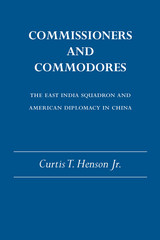 Commissioners and Commodores: The East India Squadron and American Diplomacy in China
Curtis T. Henson
University of Alabama Press, 1982 The American East India Squadron was created in 1835 by the Navy Department to extend a measure of authority to a remote corner of the globe. Americans in distant areas frequently had to cope without a naval presence, and the establishment of a permanent naval station abroad usually reflected the government’s assumption that American commercial or strategic interests were sufficiently vital to justify more than occasional visits. The appearance of a regular squadron did not necessarily imply that it would actually do anything, but rather that it would be available if the need arose. In the 19th century the American naval presence on the China coast served three constituencies: merchants, missionaries, and diplomats. The merchants had been on the China coast for half a century, but the missionaries had arrived only a few years before the establishment of the East India Squadron. The diplomats did not arrive until a decade after the squadron’s formation. Americans in the China trade showed minimal interest when the unsolicited warships appeared in 1819. The merchants were traditionally independent, and the Chinese system of trade at Canton made no allowance for foreign warships. Even after China had been forced into a treat relationship with the west, the navy made few positive contributions to the mercantile endeavor. The navy also had very little to offer the missionaries, who were few in number and whose movements were limited to areas that were open to merchants. The relationship of the squadron to the diplomatic corps was much more significant. U.S. policy expressly linked the squadron and the diplomat, not always in clear and specific terms, but certainly in a manner distinct from that of the navy’s other constituents. Diplomatic relations between China and the west legalized the navy’s presence, opening the way for warships to move freely along the coast and within the open ports. Without warships at their disposal, the commissioners and ministers found themselves immobile or subject to uncertain private transportation. Navy vessels probably rendered their greatest service as floating legations. Dr. Henson’s book traces the navy’s evolving position in China, and it stresses the relationship between the navy and the other American groups in China. He has paid particular emphasis to the commercial element, not only because the merchants were the first Americans on the China coast, but also because they continued to be the dominant American interest.
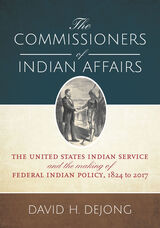 The Commissioners of Indian Affairs: The United States Indian Service and the Making of Federal Indian Policy, 1824 to 2017
David H. DeJong
University of Utah Press, 2020 Although federal Indian policies are largely determined by Congress and the executive branch, it is the commissioner and assistant secretary of Indian Affairs who must implement them. Over the past two centuries, the overarching goals of federal Indian policy have been the social and political integration and assimilation of Native Americans and the extinguishment of aboriginal title to Indian lands. These goals have been woven into policies of emigration, assimilation, acculturation, termination, reservations, and consumerism, shifting under the influence of a changing national moral compass. Indian Affairs commissioners have and continue to hold an enormous power to dictate how these policies affect the fate of Indians and their lands, a power that David H. DeJong shows has been used and misused in different ways through the years.
By examining the work of the Indian affairs commissioners and the assistant secretaries, DeJong gives new insight into how federal Indian policy has evolved and been shaped by the social, political, and cultural winds of the day.
 Commitment and Community: Communes and Utopias in Sociological Perspective
Rosabeth Moss Kanter
Harvard University Press, 1972 What makes some communes work, while others fail? Why is it so difficult to put utopian ideals into practice? In this exciting study of the success or failure of nineteenth-century American Utopias and twentieth-century communes, Rosabeth Moss Kanter combines the results of her first-hand experiences in a variety of contemporary groups with her thorough research on earlier Utopian communities. Convinced that the Utopias of the past offer important models for social organization today, the author also stresses the need for a historical perspective in viewing contemporary movements. Kanter analyzes the ideas and values expressed and developed in communal living, she explores the methods of organization that led to commitment and success or failure in the nineteenth-century, and she deals with the dilemmas and problems that contemporary communities present. The final chapters of this brilliant study, a discussion of contemporary communes, allows the reader to see the similarities as well as the differences between nineteenth and twentieth-century communities.
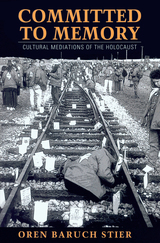 Committed to Memory: Cultural Mediations of the Holocaust
Oren Baruch Stier
University of Massachusetts Press, 2003 How is contemporary public consciousness of the Holocaust shaped and communicated? How is commitment to its memory expressed and engendered? This book offers a close and critical analysis of a range of cultural activities that mediate the Holocaust for a public increasingly distant from the events of World War II. Oren Baruch Stier argues that the manner in which those events are committed to memory, coupled with the fervent dedication to memory exhibited by many people and institutions, produces distinct memorial mediations of the Shoah.
Stier discusses how these memorializations emerge, paying attention to the ways cultural memory is embodied individually, institutionally, and technologically. He defines and examines four modes of mediation: iconic, videotestimonial, museological, and ritual-ceremonial. In each context, he analyzes how Holocaust memory is inscribed, framed, displayed, and performed through a variety of media in a range of settings. Topics include the use of Holocaust-era railway cars, Art Spiegelman's Maus volumes, novels by Emily Prager, Martin Amis, and Elie Wiesel, and a CD-ROM that incorporates excerpts from Holocaust survivor testimonies. Institutions examined range from Washington's U.S. Holocaust Memorial Museum to Los Angeles's Museum of Tolerance, from Yale's Fortunoff Video Archive for Holocaust Testimonies to the Visual History Foundation created by Steven Spielberg, to the international teen pilgrimage that is the March of the Living.
In the end, Committed to Memory asks what role forgetting can and does play in the memorial landscape, demonstrating how critical attention to our memorial investments, and to the mechanics and media of memory's construction and transmission, can uncover what is both gained and lost in these commitments.
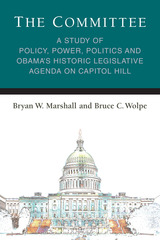 The Committee: A Study of Policy, Power, Politics and Obama's Historic Legislative Agenda on Capitol Hill
Bryan W. Marshall and Bruce C. Wolpe
University of Michigan Press, 2018 For three years while serving as a senior adviser to Rep. Henry A. Waxman (D-CA), chairman of the House Committee on Energy and Commerce—one of the most powerful committees in Congress—Bruce C. Wolpe kept a diary, a senior staffer’s look at how committees develop and promote legislation. With its insider’s view of the rough-and-tumble politics of cap-and-trade, healthcare reform, tobacco, oversight, and the debt ceiling agreement, The Committee uniquely melds the art of politics and policymaking with the theory and literature of political science. The authors engage with the important questions that political science asks about committee power, partisanship, and the strategies used to build winning policy coalitions both in the Committee and on the floor of the House. The insider politics and strategies about moving legislation in Congress, from internal and external coalition building to a chairman’s role in framing policy narratives, will captivate both novice and die-hard readers of politics.
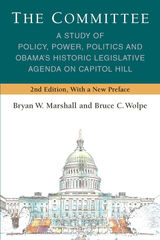 The Committee: A Study of Policy, Power, Politics and Obama’s Historic Legislative Agenda on Capitol Hill
Bryan W. Marshall and Bruce C. Wolpe
University of Michigan Press, 2021 For three years while serving as a senior adviser to Rep. Henry A. Waxman (D-CA), chairman of the House Committee on Energy and Commerce—one of the most powerful committees in Congress—Bruce C. Wolpe kept a diary, a senior staffer’s look at how committees develop and promote legislation. With its insider’s view of the rough-and-tumble politics of cap-and-trade, healthcare reform, tobacco, oversight, and the debt ceiling agreement, The Committee uniquely melds the art of politics and policymaking with the theory and literature of political science. The authors engage with the important questions that political science asks about committee power, partisanship, and the strategies used to build winning policy coalitions both in the Committee and on the floor of the House. In this new edition, the authors revisit the relationship between the executive and Congress in the wake of the sweeping changes wrought by the Trump administration, as well as thoughts about how that relationship will change again as President Biden faces a 117th Congress that is strikingly similar to Obama’s 111th. The insider politics and strategies about moving legislation in Congress, from internal and external coalition building to a chairman’s role in framing policy narratives, will captivate both novice and die-hard readers of politics.
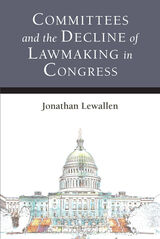 Committees and the Decline of Lawmaking in Congress
Jonathan Lewallen
University of Michigan Press, 2020 The public, journalists, and legislators themselves have often lamented a decline in congressional lawmaking in recent years, often blaming party politics for the lack of legislative output. In Committees and the Decline of Lawmaking in Congress, Jonathan Lewallen examines the decline in lawmaking from a new, committee-centered perspective. Lewallen tests his theory against other explanations such as partisanship and an increased demand for oversight with multiple empirical tests and traces shifts in policy activity by policy area using the Policy Agendas Project coding scheme.
He finds that because party leaders have more control over the legislative agenda, committees have spent more of their time conducting oversight instead. Partisanship alone does not explain this trend; changes in institutional rules and practices that empowered party leaders have created more uncertainty for committees and contributed to a shift in their policy activities. The shift toward oversight at the committee level combined with party leader control over the voting agenda means that many members of Congress are effectively cut out of many of the institution’s policy decisions. At a time when many, including Congress itself, are considering changes to modernize the institution and keep up with a stronger executive branch, the findings here suggest that strengthening Congress will require more than running different candidates or providing additional resources.
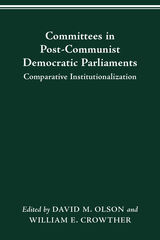 COMMITTEES IN POST-COMMUNIST DEMOCRATIC PARLIAMENTS: COMPARATIVE INSTITUTIONALIZATION
DAVID M. OLSON
Ohio State University Press, 2002 The former Communist countries of Eastern Europe provide a treasure-trove of data on the development of democratic institutions. The contributors to this volume use the recent experiences of these countries to identify how the various committee systems are structured and tie the relative strength of the committee system in each country to the relative strength of its legislature. A uniform theoretical framework connects the work of each essay and ties the parts into an informative whole. Comparative analysis based on seven indicators of institutionalization suggests that the committee systems of Hungary, Poland, and the Czech Republic are more institutionalized than those found elsewhere. Bulgaria is a middle case, while the parliaments of Moldova, Lithuania, and Estonia are the least. Of the indicators, stability in committee membership and extent of committee activity are among the most important for post-communist parliaments in their first decade. This examination of legislative committees in their beginning stages suggests that the processes of institutionalization are sequenced: expertise in a policy sector is the basis of both the assertion of jurisdictional autonomy by committees and the motive for party control of their membership and officer positions. Basic to these developments, however, is the emergence of a stable and consistent structure of the committee system as a whole. More broadly, committee attributes are closely linked to the condition and functioning of both parliamentary party groups and the government.
 Commod Bods: Embodied Heritage, Foodways, and Indigeneity
Kasey Jernigan
University of Arizona Press, 2026 The term “commod bod” is used with humor and affection. It also offers a critical way to describe bodies shaped by long-term reliance on U.S. federal commodity food programs.
In Commod Bods, Kasey Jernigan shares her ongoing collaborative research with Choctaw women and describes the ways that shifting patterns of participation in food and nutrition assistance programs (commodity foods) have shaped foodways; how these foodways are linked to bodies and health, particularly “obesity” and related conditions; and how foodways and bodies are intertwined with settler colonialism and experiences of structural violence, identity making, and heritage in the Choctaw Nation of Oklahoma.
Organized thematically, the book moves from a critical history of obesity and health in Indian Country to narratives of Choctaw women navigating food, memory, and belonging. Chapters such as “Food and Fellowship” and “Heritage, Embodied” center personal stories that show how food is not only sustenance but also a site of connection, resistance, and meaning making.
Food is critical to cultural survival and affirmation. For Choctaw people, the intentional demise of traditional foodways and dependence on federal food programs are specific experiences that inform part of what it means to be Choctaw today.
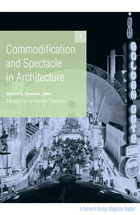 Commodification and Spectacle in Architecture: A Harvard Design Magazine Reader
William Saunders
University of Minnesota Press, 2005 More than ever, architectural design is seen as a means to promote commercial goals rather than as an end in itself. Frank Gehry’s Guggenheim Museum in Bilbao, for example, simply cannot be considered apart from its intended role as a catalyst for the economic revitalization of Bilbao and its ability to attract tourist dollars, regardless of its architectural merits. A built environment intended to seduce consumers is more likely to offer instant gratification than to invite independent thought and reflection. But how harmful, if at all, is this unprecedented commercialization of architecture?
Framed with a provocative introduction by Kenneth Frampton, the contributions to Commodification and Spectacle in Architecture stake out a variety of positions in the debate over the extent to which it is possible—or desirable—to escape from, resist, or suggest plausible alternatives to the dominant culture of consumer capitalism. Rejecting any dreamy nostalgia for an idealized present or past in which design is completely divorced from commerce—and, in some cases, celebrating the pleasures of spectacle—the individual essays range from indictments of particular architects and critiques of the profession to broader concerns about what the phenomenon of commodification means for the practice of democracy and the health of society.
Bringing together an impressive and varied group of critics and practitioners, Commodification and Spectacle in Architecture will help to sharpen the discussion of how design can respond to our hypercommodified culture.
Contributors: Michael Benedikt, Luis Fernández-Galiano, Thomas Frank, Kevin Ervin Kelley, Daniel Naegele, Rick Poynor, Michael Sorkin, Wouter Vanstiphout.
William S. Saunders is editor of Harvard Design Magazine and assistant dean for external relations at the Harvard Design School. He is the author of Modern Architecture: Photographs by Ezra Stoller.
Kenneth Frampton is Ware Professor of Architecture at Columbia University Graduate School of Architecture, Planning, and Preservation and author of many books, including Labour, Work, and Architecture.
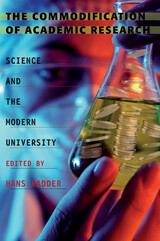 The Commodification of Academic Research: Science and the Modern University
Hans Radder
University of Pittsburgh Press, 2010
Selling science has become a common practice in contemporary universities. This commodification of academia pervades many aspects of higher education, including research, teaching, and administration. As such, it raises significant philosophical, political, and moral challenges. This volume offers the first book-length analysis of this disturbing trend from a philosophical perspective and presents views by scholars of philosophy of science, social and political philosophy, and research ethics.
The epistemic and moral responsibilities of universities, whether for-profit or nonprofit, are examined from several philosophical standpoints. The contributors discuss the pertinent epistemological and methodological questions, the sociopolitical issues of the organization of science, the tensions between commodified practices and the ideal of “science for the public good,” and the role of governmental regulation and personal ethical behavior. In order to counter coercive and corruptive influences of academic commodification, the contributors consider alternatives to commodified research and offer practical recommendations for establishing appropriate research standards, methodologies and institutional arrangements, and a corresponding normative ethos.
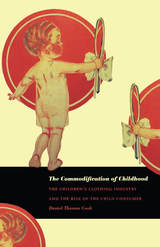 The Commodification of Childhood: The Children’s Clothing Industry and the Rise of the Child Consumer
Daniel Thomas Cook
Duke University Press, 2004 In this revealing social history, Daniel Thomas Cook explores the roots of children’s consumer culture—and the commodification of childhood itself—by looking at the rise, growth, and segmentation of the children’s clothing industry. Cook describes how in the early twentieth century merchants, manufacturers, and advertisers of children’s clothing began to aim commercial messages at the child rather than the mother. Cook situates this fundamental shift in perspective within the broader transformation of the child into a legitimate, individualized, self-contained consumer. The Commodification of Childhood begins with the publication of the children’s wear industry’s first trade journal, The Infants’ Department, in 1917 and extends into the early 1960s, by which time the changes Cook chronicles were largely complete. Analyzing trade journals and other documentary sources, Cook shows how the industry created a market by developing and promulgating new understandings of the “nature,” needs, and motivations of the child consumer. He discusses various ways that discursive constructions of the consuming child were made material: in the creation of separate children’s clothing departments, in their segmentation and layout by age and gender gradations (such as infant, toddler, boys, girls, tweens, and teens), in merchants’ treatment of children as individuals on the retail floor, and in displays designed to appeal directly to children. Ultimately, The Commodification of Childhood provides a compelling argument that any consideration of “the child” must necessarily take into account how childhood came to be understood through, and structured by, a market idiom.
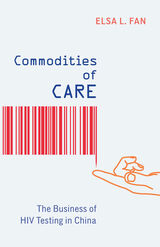 Commodities of Care: The Business of HIV Testing in China
Elsa L. Fan
University of Minnesota Press, 2021 How global health practices can end up reorganizing practices of care for the people and communities they seek to serve
Commodities of Care examines the unanticipated effects of global health interventions, ideas, and practices as they unfold in communities of men who have sex with men (MSM) in China. Targeted for the scaling-up of HIV testing, Elsa L. Fan examines how the impact of this initiative has transformed these men from subjects of care into commodities of care: through the use of performance-based financing tied to HIV testing, MSM have become a source of economic and political capital. In ethnographic detail, Fan shows how this particular program, ushered in by global health donors, became the prevailing strategy to control the epidemic in China in the late 2000s. Fan examines the implementation of MSM testing and its effects among these men, arguing that the intervention produced new markets of men, driven by the push to meet testing metrics. Fan shows how men who have sex with men in China came to see themselves as part of a global “MSM” category, adopting new selfhoods and socialities inextricably tied to HIV and to testing. Wider trends in global health programming have shaped national public health responses in China and, this book reveals, have radically altered the ways health, disease, and care are addressed.
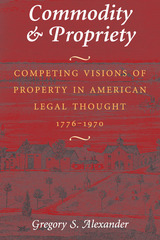 Commodity & Propriety: Competing Visions of Property in American Legal Thought, 1776-1970
Gregory S. Alexander
University of Chicago Press, 1997 Most people understand property as something that is owned, a means of creating individual wealth. But in Commodity and Propriety, the first full-length history of the meaning of property, Gregory Alexander uncovers in American legal writing a competing vision of property that has existed alongside the traditional conception. Property, Alexander argues, has also been understood as proprietary, a mechanism for creating and maintaining a properly ordered society. This view of property has even operated in periods—such as the second half of the nineteenth century—when market forces seemed to dominate social and legal relationships.
In demonstrating how the understanding of property as a private basis for the public good has competed with the better-known market-oriented conception, Alexander radically rewrites the history of property, with significant implications for current political debates and recent Supreme Court decisions.
Commodity Prices and Markets
Edited by Takatoshi Ito and Andrew K. Rose
University of Chicago Press, 2011 Fluctuations of commodity prices, most notably of oil, capture considerable attention and have been tied to important economic effects, such as inflation and low rates of economic growth. Commodity Prices and Markets advances our understanding of the consequences of these fluctuations, providing both general analysis and a particular focus on the countries of the Pacific Rim. The volume addresses three distinct subjects: the difficulties in forecasting commodity prices, the effects of exogenous commodity price shocks on the domestic economy, and the relationship between price shocks and monetary policy. The ability to forecast commodity prices is difficult but of great importance to businesses and governments, and this volume will be invaluable to professionals and policy makers interested in the field.
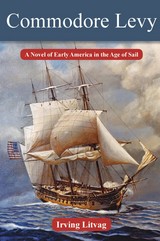 Commodore Levy: A Novel of Early America in the Age of Sail
Irving Litvag
Texas Tech University Press, 2014 An American "Dreyfus Affair"
By all accounts, Uriah Phillips Levy, the first Jewish commodore in the U.S. Navy, was both a principled and pugnacious man. On his way to becoming a flag officer, he was subjected to six courts-martial and engaged in a duel, all in response to antisemitic taunts and harassment from his fellow officers. Yet he never lost his love of country or desire to serve in its navy. When the navy tried to boot him out, he took his case to the highest court and won.
This richly detailed historical novel closely follows the actual events of Levy’s life: running away from his Philadelphia home to serve as a cabin boy at age ten; his service during the War of 1812 aboard the Argus and internment at the notorious British prison at Dartmoor; his campaign for the abolition of flogging in the Navy; and his purchase and restoration of Monticello as a tribute to his personal hero, Thomas Jefferson. Set against a broad panorama of U.S. history, Commodore Levy describes the American Jewish community from 1790 to 1860, the beginnings of the U.S. Navy, and the great nautical traditions of the Age of Sail before its surrender to the age of steam.
The Common
Gail Mazur
University of Chicago Press, 1995 At the heart of Gail Mazur's The Common is the refusal to simplify what is paradoxical in our world and a recognition of the tensions in our own divided nature. These unflinching poems create a place where wisdom and foolishness, fear and courage, rage and pity, love and diffidence, naturally co-exist.
Desire, ambition, devotion, and devastating loss are all subjects for Mazur's clear-eyed poems, which resonate with the contradictions between the body's yearning and the mind's acknowledgment of the consequences of our choices. In a poetry driven by unrelenting questioning, Mazur tries, in Rilke's worlds, "to love the questions themselves."
 Common Calling: The Laity and Governance of the Catholic Church
Stephen J. Pope, Editor
Georgetown University Press, 2004 The sexual abuse scandal in the Catholic Church has been exacerbated in the minds of many by the dismal response of church leadership. Uncovered along with the abuse of power were decisions that were not only made in secrecy, but which also magnified the powerlessness of the people of the church to have any say in its governance. Accordingly, many have left the church, many have withheld funding—others have vowed to work for change, as witnessed by the phenomenal growth of Voice of the Faithful. Common Calling is indeed a call—for change, for inclusion, and a place at the table for the laity when it comes to the governance of the church. By first providing compelling historical precedents of the roles and status of the laity as it functioned during the first millennium, Common Calling compares and contrasts those to the place of the laity today. It is this crossroad—between the past and the possible future of the Catholic Church—where the distinguished contributors to this volume gather in the hope and expectation of change. They examine the distinction between laity and clergy in regard to the power of church governance, and explore the theological interpretation of clergy-laity relations and governance in the teachings of the Second Vatican Council. They look at how church officials interpret the role of the laity today and address the weaknesses in that model. Finally, they speak clearly in outlining the ways governance may be improved, and how—by emphasizing dialogue, participation, gender equality, and loyalty—the role of the laity can be enhanced. Speaking as active believers and academic specialists, all of the contributors assert that the church must evolve in the 21st century. They represent a variety of disciplines, including systematic theology, sacramental theology, canon law, political science, moral theology, pastoral theology, and management. The book also includes an essay by James Post, cofounder of the Catholic lay movement Voice of the Faithful, the organization that was in part responsible for the resignation of Boston's Cardinal Bernard Law. Common Calling looks to a future of transparency in the Catholic Church that, with an invested laity, will help to prevent any further abuse—especially the abuse of power.
 The Common Camp: Architecture of Power and Resistance in Israel–Palestine
Irit Katz
University of Minnesota Press, 2022 Seeing the camp as a persistent political instrument in Israel–Palestine and beyond The Common Camp underscores the role of the camp as a spatial instrument employed for reshaping, controlling, and struggling over specific territories and populations. Focusing on the geopolitical complexity of Israel–Palestine and the dramatic changes it has experienced during the past century, this book explores the region’s extensive networks of camps and their existence as both a tool of colonial power and a makeshift space of resistance. Examining various forms of camps devised by and for Zionist settlers, Palestinian refugees, asylum seekers, and other groups, Irit Katz demonstrates how the camp serves as a common thread in shaping lands and lives of subjects from across the political spectrum. Analyzing the architectural and political evolution of the camp as a modern instrument engaged by colonial and national powers (as well as those opposing them), Katz offers a unique perspective on the dynamics of Israel–Palestine, highlighting how spatial transience has become permanent in the ongoing story of this contested territory. The Common Camp presents a novel approach to the concept of the camp, detailing its varied history as an apparatus used for population containment and territorial expansion as well as a space of everyday life and subversive political action. Bringing together a broad range of historical and ethnographic materials within the context of this singular yet versatile entity, the book locates the camp at the core of modern societies and how they change and transform.
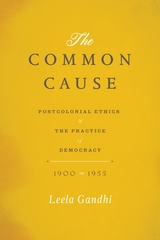 The Common Cause: Postcolonial Ethics and the Practice of Democracy, 1900-1955
Leela Gandhi
University of Chicago Press, 2014 Europeans and Americans tend to hold the opinion that democracy is a uniquely Western inheritance, but in The Common Cause, Leela Gandhi recovers stories of an alternate version, describing a transnational history of democracy in the first half of the twentieth century through the lens of ethics in the broad sense of disciplined self-fashioning. Gandhi identifies a shared culture of perfectionism across imperialism, fascism, and liberalism—an ethic that excluded the ordinary and unexceptional. But, she also illuminates an ethic of moral imperfectionism, a set of anticolonial, antifascist practices devoted to ordinariness and abnegation that ranged from doomed mutinies in the Indian military to Mahatma Gandhi’s spiritual discipline.
Reframing the way we think about some of the most consequential political events of the era, Gandhi presents moral imperfectionism as the lost tradition of global democratic thought and offers it to us as a key to democracy’s future. In doing so, she defends democracy as a shared art of living on the other side of perfection and mounts a postcolonial appeal for an ethics of becoming common.
 Common Disaster: Poems
M. Cynthia Cheung
Acre Books, 2025 A remarkable debut collection that chronicles the experience of anxiety and anguish in the face of COVID-19.
As a front-line physician, M. Cynthia Cheung started writing poetry during the worst days of the COVID-19 pandemic. Her remarkable debut collection, Common Disaster, chronicles these experiences. Confronting not just the coronavirus but also war crimes and the death of loved ones, Cheung shows us that the pandemic is only one of many disasters we hold in common. In poems that look to both the past and future, she takes a stand against the extinction of self and memory, challenging the violence of erasure.
The period covered by the book is geologic and vast. It examines present-day evidence of ancient human activity and natural history, including the Lascaux caves, asteroid craters, tar pits, and Viking ruins. The poems include ghazals, thoughtful free verse, and work that takes up the page in reframing classical Chinese oracular texts to situate the pain of a doctor in crisis.
As a physician-poet, Cheung asks us to see beyond the every day to the devastating truths about the human condition.
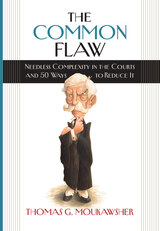 The Common Flaw: Needless Complexity in the Courts and 50 Ways to Reduce It
Thomas G. Moukawsher
Brandeis University Press, 2023 A sitting judge makes the compelling argument that we should simplify lawsuits to create a more humane and accessible legal system.
Americans are losing faith in their courts. After long delays, judges often get rid of cases for technical reasons, or force litigants to settle rather than issue a decision. When they do decide cases, we can't understand why.
The Common Flaw seeks to rid the American lawsuit of this needless complexity. The book proposes fifty changes from the filing of a complaint in court to the drafting of appellate decisions to replace the legal system’s formalism with a kind of humanism. Thomas G. Moukawsher calls for courts that decide cases promptly based more on the facts than the law, that prioritize the parties involved over lawyers, that consider the consequences for the people and the public, and that use words we can all understand. Sure to spark an important conversation about court reform, The Common Flaw makes the case for a more effective and credible legal system with warmth and humor, incorporating cartoons alongside insightful reflection.
The Common Fossils of Missouri
A. G. Unklesbay
University of Missouri Press, 1955 The Missouri Handbooks are intended to bring the products of extensive research to the general public in nontechnical yet scholarly terms and in a convenient paperback format.
The Common Good of Constitutional Democracy: Essays in Political Philosophy and on Catholic Social Teaching
Martin Rhonheimer
Catholic University of America Press, 2013 The Common Good of Constitutional Democracy offers a rich collection of essays in political philosophy by Swiss philosopher Martin Rhonheimer. Like his other books in both ethical theory and applied ethics, which have recently been published in English, the essays included are distinguished by the philosophical rigor and meticulous attention to the primary and secondary literature of the various topics discussed
 Common Ground: Democracy and Collectivity in an Age of Individualism
Jeremy Gilbert
Pluto Press, 2013 Common Ground explores the philosophical relationship between collectivity, individuality, affect and agency in the neoliberal era. Jeremy Gilbert argues that individualism is forced upon us by neoliberal culture, fatally limiting our capacity to escape the current crisis of democratic politics.
The book asks how forces and ideas opposed to neoliberal hegemony, and to the individualist tradition in Western thought, might serve to protect some form of communality, and how far we must accept assumptions about the nature of individuality and collectivity which are the legacy of an elitist tradition. Along the way it examines different ideas and practices of collectivity, from conservative notions of hierarchical and patriarchal communities to the politics of ‘horizontality’ and ‘the commons’ which are at the heart of radical movements today.
Exploring this fundamental faultline in contemporary political struggle, Common Ground proposes a radically non-individualist mode of imagining social life, collective creativity and democratic possibility.
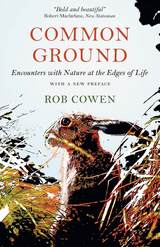 Common Ground: Encounters with Nature at the Edges of Life
Rob Cowen
University of Chicago Press, 2016 All too often, we think of nature as something distinct from ourselves, something to go and see, a place that’s separate from the ordinary modern world in which we live and work. But if we take the time to look, we soon find that’s not how nature works. Even in our parceled-out, paved-over urban environs, nature is all around us; it is in us. It is us.
That’s what Rob Cowen discovered after moving to a new home in northern England. After ten years in London he was suddenly adrift, searching for a sense of connection. He found himself drawn to a square-mile patch of waste ground at the edge of town. Scrappy, weed-filled, this heart-shaped tangle of land was the very definition of overlooked—a thoroughly in-between place that capitalism no longer had any use for, leaving nature to take its course. Wandering its meadows, woods, hedges, and fields, Cowen found it was also a magical, mysterious place, haunted and haunting, abandoned but wildly alive—and he fell in fascinated love.
Common Ground is a true account of that place and Cowen’s transformative journey through its layers and lives, but it’s much more too. As the land’s stories intertwine with events in his own life—and he learns he is to become a father for the first time—the divisions between human and nature begin to blur and shift. The place turns out to be a mirror, revealing what we are, what we’re not and how those two things are ultimately inseparable.
This is a book about discovering a new world, a forgotten world on the fringes of our daily lives, and the richness that comes from uncovering the stories and lives—animal and human—contained within. It is an unforgettable piece of nature writing, part of a brilliant tradition that stretches from Gilbert White to Robert Macfarlane and Helen Macdonald.
“I am dreaming of the edge-land again,” Cowen writes. Read Common Ground, and you, too, will be dreaming of the spaces in between, and what—including us—thrives there.
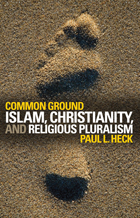 Common Ground: Islam, Christianity, and Religious Pluralism
Paul L. Heck
Georgetown University Press, 2009 Christian-Muslim interaction is a reality today in all corners of the globe, but while many celebrate the commonality of these traditions, significant differences remain. If these religions cannot be easily reconciled, can we perhaps view them through a single albeit refractive lens? This is the approach Paul Heck takes in Common Ground: To undertake a study of religious pluralism as a theological and social reality, and to approach the two religions in tandem as part of a broader discussion on the nature of the good society. Rather than compare Christianity and Islam as two species of faith, religious pluralism offers a prism through which a society as a whole—secular and religious alike—can consider its core beliefs and values. Christianity and Islam are not merely identities that designate particular communities, but reference points that all can comprehend and discuss knowledgeably. This analysis of how Islam and Christianity understand theology, ethics, and politics—specifically democracy and human rights—offers a way for that discussion to move forward.
 The Common Ground of Womanhood: Class, Gender, and Working Girls' Clubs, 1884-1928
Priscilla Murolo
University of Illinois Press, 1997 Working girls' clubs were a flash-point for class antagonisms yet also provided fertile ground for surprising cross-class alliances. Priscilla Murolo's nuanced study charts the shifting points of conflict and consensus between working women and their genteel club sponsors; working women and their male counterparts; and among working women of differing ethnic backgrounds. The working girls' club movement lasted from the 1880s, when women poured into the industrial labor force, to the 1920s. Upper-class women initially governed the clubs, and activities converged around standards of "respectability" and the defense and uplift of the character of women who worked for wages. Later, the workers themselves presided over the leadership and shifted the clubs' focus to issues of labor reform, women's rights, and sisterhood across class lines. A valuable and lucid study of the club movement, The Common Ground of Womanhood throws new light on broader trends in the history of women's alliances, social reform, gender conventions, and worker organizing.
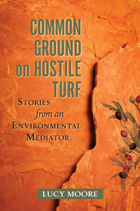 Common Ground on Hostile Turf: Stories from an Environmental Mediator
Lucy Moore
Island Press, 2013 In our increasingly polarized society, there are constant calls for compromise, for coming together. For many, these are empty talking points—for Lucy Moore, they are a life's work. As an environmental mediator, she has spent the past quarter century resolving conflicts that appeared utterly intractable. Here, she shares the most compelling stories of her career, offering insight and inspiration to anyone caught in a seemingly hopeless dispute.
Moore has worked on wide-ranging issues—from radioactive waste storage to loss of traditional grazing lands. More importantly, she has worked with diverse groups and individuals: ranchers, environmental activists, government agencies, corporations, tribal groups, and many more. After decades spent at the negotiating table, she has learned that a case does not turn on facts, legal merit, or moral superiority. It turns on people.
Through ten memorable stories, she shows how issues of culture, personality, history, and power affect negotiations. And she illustrates that equitable solutions depend on a healthy group dynamic. Both the mediator and opposing parties must be honest, vulnerable, open, and respectful. Easier said than done, but Moore proves that subtle shifts can break the logjam and reconcile even the most fiercely warring factions.
This book should be especially appealing to anyone concerned with environmental conflicts; and also to students in environmental studies, political science, and conflict resolution, and to academics and professionals in mediation and conflict resolution fields.
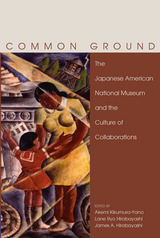 Common Ground: The Japanese American National Museum and the Culture of Collaborations
Akemi Kikumura-Yano
University Press of Colorado, 2005 Los Angeles's Japanese American National Museum, established in 1992, remains the only museum in the United States expressly dedicated to sharing the story of Americans of Japanese ancestry. The National Museum is a unique institution that operates in collaboration with other institutions, museums, researchers, audiences, and funders. In this collection of seventeen essays, anthropologists, art historians, museum curators, writers, designers, and historians provide case studies exploring collaboration with community-oriented partners in order to document, interpret, and present their histories and experiences and provide a new understanding of what museums can and should be in the United States. Current scholarship in museum studies is generally limited to interpretations by scholars and curators. Common Ground brings descriptive data to the intellectual canon and illustrates how museum institutions must be transformed and recreated to suit the needs of the twenty-first century.
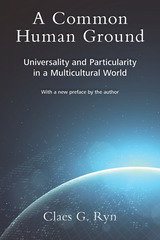 A Common Human Ground: Universality and Particularity in a Multicultural World
Claes G. Ryn
University of Missouri Press, 2019 A great challenge of the twenty-first century is the danger of conflict between persons, peoples, and cultures, among and within societies. In A Common Human Ground, Claes Ryn explores the nature of this problem and sets forth a theory about what is necessary for peaceful relations to be possible. Many in the Western world trust in “democracy,” “capitalism,” “liberal tolerance,” “scientific progress,” or “general enlightenment” to handle this problem. Although each of these, properly defined, may contribute toward alleviating disputes, Ryn argues that the problem is much more complex and demanding than is usually recognized. He reasons that, most fundamentally, good relations among individuals and nations have moral and cultural preconditions. What can predispose them to mutual respect and peace? One Western philosophical tradition, for which Plato set the pattern, maintains that the only way to genuine unity is for historical diversity to yield to universality. The implication of this view for a multicultural world would be a peace that requires that cultural distinctiveness be effaced as far as possible and replaced with a universal culture. A very different Western philosophical tradition denies the existence of universality altogether. It is represented today by postmodernist multiculturalism—a view that leaves unanswered the question as to how conflict between diverse groups might be averted. Ryn questions both of these traditions, arguing for the potential union of universality and particularity. He contends that the two need not be enemies, but in fact need each other. Cultivating individual and national particularities is potentially compatible with strengthening and enriching our common humanity. This volume embraces the notion of universality, while at the same time historicizing it. Using wide-ranging examples, Ryn presents a firmly sustained and systematic argument centering on this central issue. His approach is interdisciplinary, discussing not only political ideas, but also fiction, drama, and other arts. Scholarly and philosophical, but not specialized, this book will appeal to general readers as well as intellectuals.
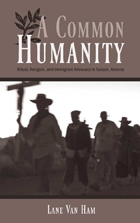 A Common Humanity: Ritual, Religion, and Immigrant Advocacy in Tucson, Arizona
Lane Van Ham
University of Arizona Press, 2011 As debate about immigration policy rages from small towns to state capitals, from coffee shops to Congress, would-be immigrants are dying in the desert along the US–Mexico border. Beginning in the 1990s, the US government effectively sealed off the most common border crossing routes. This had the unintended effect of forcing desperate people to seek new paths across open desert. At least 4,000 of them died between 1995 and 2009. While some Americans thought the dead had gotten what they deserved, other Americans organized humanitarian aid groups. A Common Humanity examines some of the most active aid organizations in Tucson, Arizona, which has become a hotbed of advocacy on behalf of undocumented immigrants.
This is the first book to examine immigrant aid groups from the inside. Author Lane Van Ham spent more than three years observing the groups and many hours in discussions and interviews. He is particularly interested in how immigrant advocates both uphold the legitimacy of the United States and maintain a broader view of its social responsibilities. By advocating for immigrants regardless of their documentation status, he suggests, advocates navigate the conflicting pulls of their own nation-state citizenship and broader obligations to their neighbors in a globalizing world. And although the advocacy organizations are not overtly religious, Van Ham finds that they do employ religious symbolism as part of their public rhetoric, arguing that immigrants are entitled to humane treatment based on universal human values.
Beautifully written and immensely engaging, A Common Humanity adds a valuable human dimension to the immigration debate.
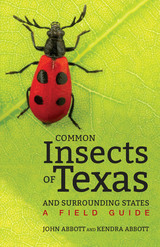 Common Insects of Texas and Surrounding States: A Field Guide
By John Abbott and Kendra Abbott
University of Texas Press, 2020 Thanks to its size and geographic position, Texas is home to nearly 30,000 species of insects, likely making its insect population the most diverse in the nation. Ranging from eastern and western to temperate and tropical species, this vast array of insects can be difficult to identify. In Common Insects of Texas and Surrounding States, John and Kendra Abbott have created the state's most comprehensive field guide to help readers recognize and understand these fascinating creatures. Containing 1,300 species and more than 2,700 photographs, this guide offers a wealth of information about the characteristics and behaviors of Texas's insects. Each chapter introduces an order with a discussion of general natural history and a description of other qualities helpful in distinguishing its various species, while every species' entry provides a state map showing where it is most likely to be found, a key displaying its seasonal distribution, information about its habitat, and corresponding photos. Featuring colored tabs for quick reference, a glossary, and information about other arthropods, this guide is the perfect companion for anyone wanting to identify and learn more about the many insects of Texas.
Common Interior Alaska Cryptogams: Fungi, Lichenicolous Fungi, Lichenized Fungi, Slime Molds, Mosses, and Liverworts
Gary A. Laursen and Rodney D. Seppelt
University of Alaska Press, 2009 With Common Interior Alaska Cryptogams, Gary A. Laursen and Rodney Seppelt offer the first field guide to cryptogams of the Denali National Park and Preserve. Useful to both lay and professional investigators, this fully illustrated compendium covers mushroom fungi, lichenized fungi, lichenicolous fungi, slime molds, mosses, and liverworts. This field guide to commonly seen cryptogams will provide a basis for understanding their vast diversity of taxa, speciation, edibility, relative abundance, and utility, as well as the ecological roles played by these organisms.
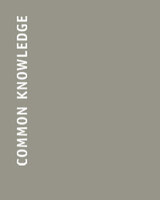 Common Knowledge (Inaugural issue marking return to publication), Volume 8
Jeffrey M. Perl, ed.
Duke University Press Duke University Press is pleased to begin publishing Common Knowledge with its re- inaugural issue, volume 8, number 1 Described by the New York Times as one of two American journals in which public intellectuals and other scholars prefer to publish, the highly acclaimed Common Knowledge has returned to publication after a two-year hiatus. In an effort to place itself in the ferment of intellectual life and broaden its geographical range, the journal has moved to the Middle East, to Israel. Born in an attempt to moderate and get past the "culture wars" of the 90s, Common Knowledge has moved, literally, to a war zone, and accordingly its editorial interests have broadened to include culture wars of a less metaphorical kind.
Its mission is both incredibly ambitious and shockingly simple: to open up lines of communication between the academy and the community of thoughtful people outside its walls. Common Knowledge was created to form a new intellectual model, one based on conversation or cooperation rather than on metaphors adopted from sports and war, of "sides" that one must "take." The journal will collect work from a variety of fields and specialties, including philosophy, religion, psychology, literary criticism, cultural studies, art history, political science, and social, cultural, and intellectual history.
Scholars such as Richard Rorty, Bruno Latour, Clifford Geertz, Julia Kristeva, Karma Nabulsi, and J. G. A. Pocock will cross paths with political figures like Prince Hassan of Jordan and President Arpad Goncz of Hungary, novelists like Susan Sontag, poets like Yves Bonnefoy, composers like Alexander Goehr, and journalists like Adam Michnik. The pages of Common Knowledge are sure to challenge the ways we think about theory and its relevance to humanity. The first volume will feature the beginning of a Seriatim Symposium, “Disagreement, Enmity, and Dispute,” which will include discussions of the title concepts from a variety of theoretical perspectives. The Symposium asks why, in an intellectual context in which “true” and “real” are words that can be used only in condescending scare quotes, there is so much absolute conflict. If truth and reality are constructions, then why aren’t we constructing consensual orders (metaphysical and social) that are conducive to peace, calm, and cooperation? Contributors for forthcoming issues include: Manfred Frank, Jacques Le Goff, Vicki Hearne, Sissela Bok, Edward Cardinal Cassidy, Linda Hutcheon, G. Thomas Tanselle, Arlette Farge, Marcel Detienne, Caryl Emerson, Stanley Katz, and Peter Laslett.
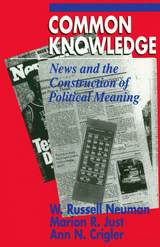 Common Knowledge: News and the Construction of Political Meaning
W. Russell Neuman, Marion R. Just, and Ann N. Crigler
University of Chicago Press, 1992 Photo opportunities, ten-second sound bites, talking heads and celebrity anchors: so the world is explained daily to millions of Americans. The result, according to the experts, is an ignorant public, helpless targets of a one-way flow of carefully filtered and orchestrated communication. Common Knowledge shatters this pervasive myth. Reporting on a ground-breaking study, the authors reveal that our shared knowledge and evolving political beliefs are determined largely by how we actively reinterpret the images, fragments, and signals we find in the mass media.
For their study, the authors analyzed coverage of 150 television and newspaper stories on five prominent issues—drugs, AIDS, South African apartheid, the Strategic Defense Initiative, and the stock market crash of October 1987. They tested audience responses of more than 1,600 people, and conducted in-depth interviews with a select sample. What emerges is a surprisingly complex picture of people actively and critically interpreting the news, making sense of even the most abstract issues in terms of their own lives, and finding political meaning in a sophisticated interplay of message, medium, and firsthand experience.
At every turn, Common Knowledge refutes conventional wisdom. It shows that television is far more effective at raising the saliency of issues and promoting learning than is generally assumed; it also undermines the assumed causal connection between newspaper reading and higher levels of political knowledge. Finally, this book gives a deeply responsible and thoroughly fascinating account of how the news is conveyed to us, and how we in turn convey it to others, making meaning of at once so much and so little. For anyone who makes the news—or tries to make anything of it—Common Knowledge promises uncommon wisdom.
 Common Lands, Common People: The Origins of Conservation in Northern New England
Richard W. Judd
Harvard University Press, 1997 In this innovative study of the rise of the conservation ethic in northern New England, Richard Judd shows that the movement that eventually took hold throughout America had its roots among the communitarian ethic of countrypeople rather than among urban intellectuals or politicians. Drawing on agricultural journals and archival sources such as legislative petitions, Judd demonstrates that debates over access to and use of forests and water, though couched in utilitarian terms, drew their strength and conviction from deeply held popular notions of properly ordered landscapes and common rights to nature.
Unlike earlier attempts to describe the conservation movement in its historical context, which have often assumed a crude dualism in attitudes toward nature--democracy versus monopoly, amateur versus professional, utilitarian versus aesthete--this study reveals a complex set of motives and inspirations behind the mid-nineteenth-century drive to conserve natural resources. Judd suggests that a more complex set of contending and complementary social forces was at work, including traditional folk values, an emerging science of resource management, and constantly shifting class interests.
Common Lands, Common People tells us that ordinary people, struggling to define and redefine the morality of land and resource use, contributed immensely to America's conservation legacy.
The Common Law
Oliver Wendell Holmes Jr.
Harvard University Press, 2009 Much more than an historical examination of liability, criminal law, torts, bail, possession and ownership, and contracts, The Common Law articulates the ideas and judicial theory of one of the greatest justices of the Supreme Court. G. Edward White reminds us why the book remains essential reading not only for law students but also for anyone interested in American history. The text published is, with occasional corrections of typographical errors, identical with that found in the first and all subsequent printings by Little, Brown.
 A Common Law for Europe
Barbara Pasa
Central European University Press, 2005 An essential guide for lawmakers, scholars, and students of law, this work takes on the formidable task of providing a detailed overview of the harmonization of law in the European Union. Skillfully researched, the authors seek to approach this topic with an eye to the recent enlargement process. In highlighting the most recent actions of the European Court of Justice and the Court of First Instance, the book seeks to analyze the future strengths and pitfalls of EU Common Law. Court rulings are quoted at length, and work in conjunction with text inserts in providing a format that breaks down complex information. This open style of the book gives researchers the ability to quickly locate useful information and cite statements from EU institutions. In outlining the sources and institutions of Community Law, and the challenges in harmonizing national and supra-national law-books, 'A Common Law for Europe' has done a tremendous service for academics and future leaders of the European Union.
A Common Law for the Age of Statutes
Guido Calabresi
Harvard University Press, 1982 The dominance of legislatures and statutory law has put an impossible burden on the courts. Guido Calabresi thinks it is time for this country seriously to consider returning to a traditional American judicial–legislative balance in which courts would enlarge the common law and would also decide when a rule of law has seen its day and should be revised.
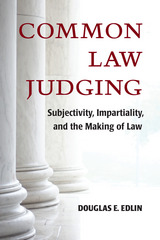 Common Law Judging: Subjectivity, Impartiality, and the Making of Law
Douglas E. Edlin
University of Michigan Press, 2016 Are judges supposed to be objective? Citizens, scholars, and legal professionals commonly assume that subjectivity and objectivity are opposites, with the corollary that subjectivity is a vice and objectivity is a virtue. These assumptions underlie passionate debates over adherence to original intent and judicial activism.
In Common Law Judging, Douglas Edlin challenges these widely held assumptions by reorienting the entire discussion. Rather than analyze judging in terms of objectivity and truth, he argues that we should instead approach the role of a judge’s individual perspective in terms of intersubjectivity and validity. Drawing upon Kantian aesthetic theory as well as case law, legal theory, and constitutional theory, Edlin develops a new conceptual framework for the respective roles of the individual judge and of the judiciary as an institution, as well as the relationship between them, as integral parts of the broader legal and political community. Specifically, Edlin situates a judge’s subjective responses within a form of legal reasoning and reflective judgment that must be communicated to different audiences.
Edlin concludes that the individual values and perspectives of judges are indispensable both to their judgments in specific cases and to the independence of the courts. According to the common law tradition, judicial subjectivity is a virtue, not a vice.
The Common Legal Past of Europe, 1000–1800
Manlio Bellomo
Catholic University of America Press, 1995 With a vigor and passion rarely found in a scholarly text, Manlio Bellomo has written a broad history of the western European legal tradition. It is now made available to an English-speaking audience in an elegant and lucid translation from the original Italian.
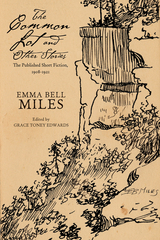 The Common Lot and Other Stories: The Published Short Fiction, 1908–1921
Emma Bell Miles
Ohio University Press, 2016 The seventeen narratives of The Common Lot and Other Stories, published in popular magazines across the United States between 1908 and 1921 and collected here for the first time, are driven by Emma Bell Miles’s singular vision of the mountain people of her home in southeastern Tennessee. That vision is shaped by her strong sense of social justice, her naturalist’s sensibility, and her insider’s perspective. Women are at the center of these stories, and Miles deftly works a feminist sensibility beneath the plot of the title tale about a girl caught between present drudgery in her father’s house and prospective drudgery as a young wife in her own. Wry, fiery, and suffused with details of both natural and social worlds, the pieces collected here provide a particularly acute portrayal of Appalachia in the early twentieth century. Miles’s fiction brings us a world a century in the past, but one that will easily engage twenty-first-century readers. The introduction by editor and noted Miles expert Grace Toney Edwards places Miles in the literary context of her time. Edwards highlights Miles’s quest for women’s liberation from patriarchal domination and oppressive poverty, forces against which Miles herself struggled in making a name for herself as a writer and artist. Illustrations by the author and Miles family photographs complement the stories.
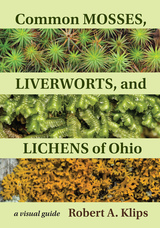 Common Mosses, Liverworts, and Lichens of Ohio: A Visual Guide
Robert Klips
Ohio University Press, 2022 This engaging illustrated guidebook reveals the fascinating mosses and lichens that homeowners, outdoorspeople, and nature lovers encounter every day in Ohio and the Midwest. In this guide to the most common and distinctive moss, liverwort, and lichen species in Ohio, readers will find concise physical descriptions, facts about natural history and ecology, and tips to distinguish look-alike species, all presented in a friendly, conversational tone. Featuring detailed photographs of the plant and plantlike species in their natural settings, the book covers 106 mosses, thirty liverworts, and one hundred lichens and offers several avenues to match a specimen to its description page. “Where They Grow” chapters spotlight species commonly encountered on field outings, and field keys to help readers quickly identify unfamiliar samples. While designed primarily as an identification tool, this guide also frames moss and lichen spotting in a scientific context. The two main sections—bryophytes and lichens—detail their respective taxonomic kingdoms, explain their life cycles and means of reproduction, and illustrate variation in the traits used for identification. The book is an introduction to the biology of these intriguing but too-often-overlooked organisms and a means to enjoy, identify, and catalog the biodiversity all around us.
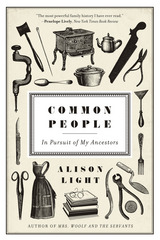 Common People: In Pursuit of My Ancestors
Alison Light
University of Chicago Press, 2015 “Family history begins with missing persons,” Alison Light writes in Common People. We wonder about those we’ve lost, and those we never knew, about the long skein that led to us, and to here, and to now. So we start exploring.
Most of us, however, give up a few generations back. We run into a gap, get embarrassed by a ne’er-do-well, or simply find our ancestors are less glamorous than we’d hoped. That didn’t stop Alison Light: in the last weeks of her father’s life, she embarked on an attempt to trace the history of her family as far back as she could reasonably go. The result is a clear-eyed, fascinating, frequently moving account of the lives of everyday people, of the tough decisions and hard work, the good luck and bad breaks, that chart the course of a life. Light’s forebears—servants, sailors, farm workers—were among the poorest, traveling the country looking for work; they left few lasting marks on the world. But through her painstaking work in archives, and her ability to make the people and struggles of the past come alive, Light reminds us that “every life, even glimpsed through the chinks of the census, has its surprises and secrets.”
What she did for the servants of Bloomsbury in her celebrated Mrs. Woolf and the Servants Light does here for her own ancestors, and, by extension, everyone’s: draws their experiences from the shadows of the past and helps us understand their lives, estranged from us by time yet inextricably interwoven with our own. Family history, in her hands, becomes a new kind of public history.
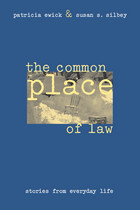 The Common Place of Law: Stories from Everyday Life
Patricia Ewick and Susan S. Silbey
University of Chicago Press, 1998 Why do some people not hesitate to call the police to quiet a barking dog in the middle of the night, while others accept the pain and losses associated with defective products, unsuccesful surgery, and discrimination? Patricia Ewick and Susan Silbey collected accounts of the law from more than four hundred people of diverse backgrounds in order to explore the different ways that people use and experience it. Their fascinating and original study identifies three common narratives of law that are captured in the stories people tell.
One narrative is based on an idea of the law as magisterial and remote. Another views the law as a game with rules that can be manipulated to one's advantage. A third narrative describes the law as an arbitrary power that is actively resisted. Drawing on these extensive case studies, Ewick and Silbey present individual experiences interwoven with an analysis that charts a coherent and compelling theory of legality. A groundbreaking study of law and narrative, The Common Place of Law depicts the institution as it is lived: strange and familiar, imperfect and ordinary, and at the center of daily life.
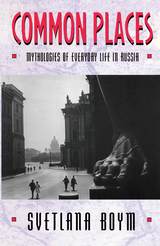 Common Places: Mythologies of Everyday Life in Russia
Svetlana Boym
Harvard University Press, 1995 What is the “real Russia”? What is the relationship between national dreams and kitsch, between political and artistic utopia and everyday existence? Commonplaces of daily living would be perfect clues for those seeking to understand a culture. But all who write big books on Russian life confess their failure to get properly inside Russia, to understand its “doublespeak.”
Svetlana Boym is a unique guide. A member of the last Soviet Generation, the Russian equivalent of our Generation X, she grew up in Leningrad and has lived in the West for the past thirteen years. Her book provides a view of Russia that is historically informed, replete with unexpected detail, and everywhere stamped with authority. Alternating analysis with personal accounts of Russian life, Boym conveys the foreignness of Russia and examines its peculiar conceptions of private life and common good, of Culture and Trash, of sincerity and banality. Armed with a Dictionary of Untranslatable Terms, we step around Uncle Fedia asleep in the hall, surrounded by a puddle of urine, and enter the Communal Apartment, the central exhibit of the book. It is the ruin of the communal utopia and a unique institution of Soviet daily life; a model Soviet home and a breeding ground for grassroots informants. Here, privacy is forbidden; here the inhabitants defiantly treasure their bits of “domestic trash,” targets of ideological campaigns for the transformation (perestroika) of everyday life.
Against the Russian and Soviet myths of national destiny, the trivial, the ordinary, even the trashy, take on a utopian dimension. Boym studies Russian culture in a broad sense of the word; she ranges from nineteenth- and twentieth-century intellectual thought to art and popular culture. With her we go walking in Moscow and Leningrad, eavesdrop on domestic life, and discover jokes, films, and TV programs. Boym then reflects on the 1991 coup that marked the end of the Soviet Union and evoked fin-de-siècle apocalyptic visions. The book ends with a poignant reflection on the nature of communal utopia and nostalgia, on homesickness and the sickness of being home.
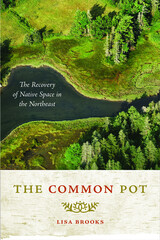 The Common Pot: The Recovery of Native Space in the Northeast
Lisa Brooks
University of Minnesota Press, 2008 Illuminates the significance of writing to colonial-era Native American resistance Literary critics frequently portray early Native American writers either as individuals caught between two worlds or as subjects who, even as they defied the colonial world, struggled to exist within it. In striking counterpoint to these analyses, Lisa Brooks demonstrates the ways in which Native leaders—including Samson Occom, Joseph Brant, Hendrick Aupaumut, and William Apess—adopted writing as a tool to reclaim rights and land in the Native networks of what is now the northeastern United States. “The Common Pot,” a metaphor that appears in Native writings during the eighteenth and nineteenth centuries, embodies land, community, and the shared space of sustenance among relations. Far from being corrupted by forms of writing introduced by European colonizers, Brooks contends, Native people frequently rejected the roles intended for them by their missionary teachers and used the skills they acquired to compose petitions, political tracts, and speeches; to record community councils and histories; and most important, to imagine collectively the routes through which the Common Pot could survive.Reframing the historical landscape of the region, Brooks constructs a provocative new picture of Native space before and after colonization. By recovering and reexamining Algonquian and Iroquoian texts, she shows that writing was not a foreign technology but rather a crucial weapon in the Native Americans’ arsenal as they resisted—and today continue to oppose—colonial domination.
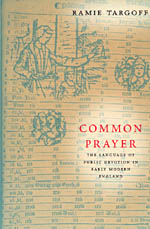 Common Prayer: The Language of Public Devotion in Early Modern England
Ramie Targoff
University of Chicago Press, 2001 Common Prayer explores the relationship between prayer and poetry in the century following the Protestant Reformation. Ramie Targoff challenges the conventional and largely misleading distinctions between the ritualized world of Catholicism and the more individualistic focus of Protestantism. Early modern England, she demonstrates, was characterized less by the triumph of religious interiority than by efforts to shape public forms of devotion. This provocatively revisionist argument will have major implications for early modern studies.
Through readings of William Shakespeare's Hamlet, Richard Hooker's Lawes of Ecclesiastical Politie, Philip Sidney's Apology for Poetry and his translations of the Psalms, John Donne's sermons and poems, and George Herbert's The Temple, Targoff uncovers the period's pervasive and often surprising interest in cultivating public and formalized models of worship. At the heart of this study lies an original and daring approach to understanding the origins of devotional poetry; Targoff shows how the projects of composing eloquent verse and improving liturgical worship come to be deeply intertwined. New literary practices, then, became a powerful means of forging common prayer, or controlling private and otherwise unmanageable expressions of faith.
The Common Rocks and Minerals of Missouri
W. D. Keller
University of Missouri Press, 1961 The Missouri Handbooks are intended to bring the products of extensive research to the general public in nontechnical yet scholarly terms and in a convenient paperback format.
Common Sense
Thomas Paine
Harvard University Press, 2010 “In Common Sense a writer found his moment to change the world,” Alan Taylor writes in his introduction. When Paine’s attack on the British mixed constitution of kings, lords, and commons was published in January 1776, fighting had already erupted between British troops and American Patriots, but many Patriots still balked at seeking independence. “By discrediting the sovereign king,” Taylor argues, “Paine made independence thinkable—as he relocated sovereignty from a royal family to the collective people of a republic.” Paine’s American readers could conclude that they stood at “the center of a new and coming world of utopian potential.” The John Harvard Library edition follows the text of the expanded edition printed by the shop of Benjamin Towne for W. and T. Bradford of Philadelphia.
 Common Sense: A Political History
Sophia Rosenfeld
Harvard University Press, 2014 Common sense has always been a cornerstone of American politics. In 1776, Tom Paine’s vital pamphlet with that title sparked the American Revolution. And today, common sense—the wisdom of ordinary people, knowledge so self-evident that it is beyond debate—remains a powerful political ideal, utilized alike by George W. Bush’s aw-shucks articulations and Barack Obama’s down-to-earth reasonableness. But far from self-evident is where our faith in common sense comes from and how its populist logic has shaped modern democracy. Common Sense: A Political History is the first book to explore this essential political phenomenon.
The story begins in the aftermath of England’s Glorious Revolution, when common sense first became a political ideal worth struggling over. Sophia Rosenfeld’s accessible and insightful account then wends its way across two continents and multiple centuries, revealing the remarkable individuals who appropriated the old, seemingly universal idea of common sense and the new strategic uses they made of it. Paine may have boasted that common sense is always on the side of the people and opposed to the rule of kings, but Rosenfeld demonstrates that common sense has been used to foster demagoguery and exclusivity as well as popular sovereignty. She provides a new account of the transatlantic Enlightenment and the Age of Revolutions, and offers a fresh reading on what the eighteenth century bequeathed to the political ferment of our own time. Far from commonsensical, the history of common sense turns out to be rife with paradox and surprise.
The Common Sense of Science: With a New Preface by Sir Hermann Bondi
J. Bronowski
Harvard University Press J. Bronowski was both a distinguished mathematician and a poet, a philosopher of science and a literary critic who wrote a well-known study of William Blake. Dr. Bronowski’s very career was founded on the premise of an intimate connection between science and the humanities, disciplines which are still generally thought to be worlds apart.
The Common Sense of Science, a book which remains as topical today as it was when it first appeared twenty-five years ago, articulates and develops Bronowski’s provocative idea that the sciences and the arts fundamentally share the same imaginative vision.
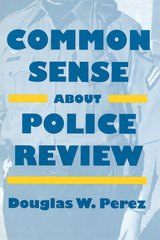 Common Sense Police Review
Douglas Perez
Temple University Press, 1995 "This book provides knowledge that will be useful to city governments, civil rights organizations, community leaders, clergy, civilian review board advocates, as well as police chiefs and unions. It sheds considerable light on an important issue...[and] makes clear that there are wide ranging variations among departments in policies, accepted practices, management control of the use of force, and accountability of supervisors and officers who use excessive force."
--Patrick V. Murphy, Director, Police Policy Board of the U.S. Conference of Mayors
Common Sense about Police Review is the first comparative study to consider both civilian and internal police review processes. Using survey research of police attitudes and citizen complaints compiled over fifteen years from police departments across the nation, Douglas W. Perez analyzes past and current review systems as a way to develop criteria for comparing three archetypal systems of police review: internal, external (civilian), and hybrid forms of the two.
High media visibility of several events--the 1988 police riot in New York City's Tompkins Square, the 1991 videotaped beating of Rodney King, and the 1992 beating death of Malice Green by Detroit police detectives--has brought police review back into the public arena; not since civil rights demonstrators clashed with police in the 1960s has officer accountability been so hotly debated.
Crucial to any monitoring system are guidelines, which Perez stresses must insist on rigorous investigations of alleged police abuses, outline strict limitations of police action, strive to bridge gaps between police officers and citizens, and exonerate officers who are found to have acted properly and legally. With these standards, the author asserts, a balance between self-sanctioning and enforced regulation can be achieved. Examining fairness, objectivity, and thoroughness in review systems throughout the country, Perez offers a model for the "ideal" police review system. Included are valuable discussions of both the causes of police attitudes and behavior and the misconceptions and expectations that can contribute to a pervasive public image of police malpractice. Perez provides helpful reflections on the role of politicians and administrators in implementing and maintaining police accountability.
A Common Spring: Crime Novel and Classic
Nadya Aisenberg
University of Wisconsin Press, 1980 Nadya Aisenberg discusses the potentialities of the crime novel, its implications, principles, and scope, and its analogy ot myth and the fairy tale. She proposes that the detective story and the thriller have made an unacknowledged contribution to "serious" literature. Her discussion of Dickens, Conrad, and Green indicate that each borrowed many important ingredients from the formulaic novel.
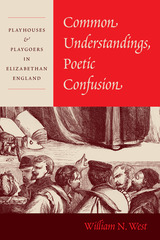 Common Understandings, Poetic Confusion: Playhouses and Playgoers in Elizabethan England
William N. West
University of Chicago Press, 2021 A new account of playgoing in Elizabethan England, in which audiences participated as much as performers.
What if going to a play in Elizabethan England was more like attending a football match than a Broadway show—or playing in one? In Common Understandings, Poetic Confusion, William N. West proposes a new account of the kind of participatory entertainment expected by the actors and the audience during the careers of Shakespeare and his contemporaries. West finds surprising descriptions of these theatrical experiences in the figurative language of early modern players and playgoers—including understanding, confusion, occupation, eating, and fighting. Such words and ways of speaking are still in use today, but their earlier meanings, like that of theater itself, are subtly, importantly different from our own. Playing was not confined to the actors on the stage but filled the playhouse, embracing audiences and performers in collaborative experiences that did not belong to any one alone but to the assembled, various crowd. What emerged in playing was a kind of thinking and feeling distributed across persons and times that were otherwise distinct. Thrown apples, smashed bottles of beer, and lumbering bears—these and more gave verbal shape to the physical interactions between players and playgoers, creating circuits of exchange, production, and consumption.
Common Values
Sissela Bok
University of Missouri Press, 2002 In Common Values, now with a new preface,Bok writes eloquently and clearly while combining moral theory with practical ethics, demonstrating how moral values apply to all facets of life—personal, professional, domestic, and international. Drawing on a great deal of historical material, Bok also includes in her examination consideration of the 1993 United Nations World Conference on Human Rights; the World Parliament of Religions; the publication of Veritatis Splendor, Pope John Paul II's proclamation on morality; and the International Commission of Global Governance. Bok's defense of shared morality addresses a crucial topic for our time.
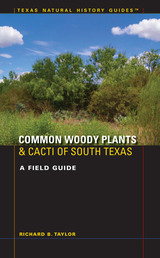 Common Woody Plants and Cacti of South Texas: A Field Guide
By Richard B. Taylor with Texas Parks & Wildlife Department
University of Texas Press, 2014 Woody plants and cacti are vital staple foods for cattle, deer, and other wildlife in drought-prone South Texas. Ranchers, hunters, and land managers who need to identify these plants relied on A Field Guide to Common South Texas Shrubs (published by Texas Parks & Wildlife Press and distributed by UT Press), which is no longer in print. Responding to ongoing demand for the book, Richard B. Taylor has completely updated and expanded it with seven new species, new photographs, and a quick plant identification key. Common Woody Plants and Cacti of South Texas is an easy-to-use plant identification field guide to fifty species that comprise an estimated 90 percent of the region’s woody canopy cover north of the Rio Grande Valley. The species accounts include photographs, descriptions, values to livestock and wildlife, and nutritional information. The book also provides historical perspectives and information on brush management techniques and strategies, as well as habitat appraisal. All of these resources will enable readers to analyze stocking rates for deer and cattle, evaluate a prospective hunting lease, or buy property.
Common-Channel Signalling
Richard J. Manterfield
The Institution of Engineering and Technology, 1991 Signalling is the life-blood of telecommunications and common-channel signalling is the key to providing flexible and cost-effective services to customers. This book commences with the basics of signalling and then unveils the complexities of common-channel signalling systems. The book is written to appeal to a wide range of readership. The novice can build up a comprehensive understanding of signalling by systematically making progress through the book. Experts in telecommunications who wish to understand the specialist subject can select appropriate text, guided by the chapter summaries. Experts in signalling will find the book useful in extending their knowledge of a very broad subject. The glossary cuts through the maze of jargon.
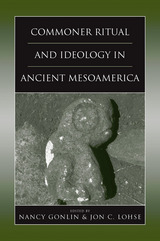 Commoner Ritual and Ideology in Ancient Mesoamerica
Nancy Gonlin
University Press of Colorado, 2016 Were most commoners in ancient Mesoamerica poor? In a material sense, yes, probably so. Were they poor in their beliefs and culture? Certainly not, as Commoner Ritual and Ideology in Ancient Mesoamerica demonstrates.
This volume explores the ritual life of Mesoamerica's common citizens, inside and outside of the domestic sphere, from Formative through Postclassic periods. Building from the premise that ritual and ideological expression inhered at all levels of society in Mesoamerica, the contributors demonstrate that ideology did not emanate solely from exalted individuals and that commoner ritual expression was not limited to household contexts. Taking an empirical approach to this under-studied and under-theorized area, contributors use material evidence to discover how commoner status conditioned the expression of ideas and values.
Revealing complex social hierarchies that varied across time and region, this volume offers theoretical approaches to commoner ideology, religious practice, and sociopolitical organization and builds a framework for future study of the correlation of ritual and ideological expression with social position for Mesoamericanists and archaeologists worldwide.
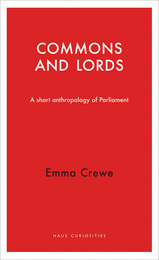 Commons and Lords: A Short Anthropology of Parliament
Emma Crewe
Haus Publishing, 2015 The British Parliament rewards close scrutiny not just for the sake of democracy, but also because the surprises it contains challenge our understanding of British politics. Commons and Lords pulls back the curtain on both the upper House of Lords and the lower House of Commons to examine their unexpected inner workings.
Based on fieldwork within both Houses, this volume in the Haus Curiosities series provides a surprising twist in how relationships in each play out. The high social status of peers in the House of Lords gives the impression of hierarchy and, more specifically, patriarchy. In contrast, the House of Commons conjures impressions of equality and fairness between members. But actual observation reveals the opposite: while the House of Lords has an egalitarian and cooperative ethos that is also supportive of female members, the competitive and aggressive House of Commons is a far less comfortable place for women. Offering many surprises and secrets, this book exposes the sheer oddity of the British parliament system.
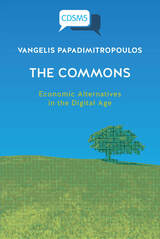 T?he Commons: Economic Alternatives in the Digital Age
Vangelis Papadimitropoulos
University of Westminster Press, 2020 This book explores the potential creation of a broader collaborative economy through commons-based peer production (P2P) and the emergent role of information and communication technologies (ICTs). The book seeks to critically engage in the political discussion of commons-based peer production, which can be classified into three basic arguments: the liberal, the reformist and the anti-capitalist. This book categorises the liberal argument as being in favour of the coexistence of the commons with the market and the state. Reformists, on the other hand, advocate for the gradual adjustment of the state and of capitalism to the commons, while anti-capitalists situate the commons against capitalism and the state. By discussing these three viewpoints, the book contributes to contemporary debates concerning the future of commons-based peer production. Further, the author argues that for the commons to become a fully operational mode of peer production, it needs to reach critical mass arguing that the liberal argument underestimates the reformist insight that technology has the potential to decentralise production, thereby forcing capitalism to transition to post-capitalism. Surveying the three main strands of commons-based peer production, this book makes the case for a post-capitalist commons-orientated transition that moves beyond neoliberalism.
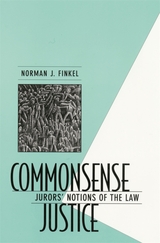 Commonsense Justice: Jurors’ Notions of the Law
Norman J. Finkel
Harvard University Press, 2011 For the first time in our history, U.S. prisons house over a million inmates, enough to populate a city larger than San Francisco. Building prisons is the new growth industry, as the American public reacts to a perceived increase in violence and politicians take a hard line toward crime. But this eagerness to construct more prisons raises basic questions about what the community wants and will tolerate and what the Supreme Court will sanction.
In this timely book, Norman Finkel looks at the relationship between the “law on the books,” as set down in the Constitution and developed in cases and decisions, and what he calls “commonsense justice,” the ordinary citizen’s notions of what is just and fair. Law is an essentially human endeavor, a collection of psychological theories about why people think, feel, and behave as they do, and when and why we should find some of them blameworthy and punishable. But is it independent of community sentiment, as some would contend? Or, as Finkel suggests, do juries bring the community’s judgment to bear on the moral blameworthiness of the defendant? When jurors decide that the law is unfair, or the punishment inappropriate for a particular defendant, they have sometimes nullified the law.
Nullification represents the jury’s desire not to defeat but “to perfect and complete” the law. It is the “no confidence” vote of commonsense justice refusing to follow the path the law has marked out—and pointing to a new path based on what seem to be more just grounds. Finkel brings to life the story behind the jury and judicial decisions, interweaving anecdotes, case law, and social science research to present a balanced and comprehensive view of important legal and social policy issues.
 Commonwealth
Michael Hardt and Antonio Negri
Harvard University Press, 2009 When Empire appeared in 2000, it defined the political and economic challenges of the era of globalization and, thrillingly, found in them possibilities for new and more democratic forms of social organization. Now, with Commonwealth, Michael Hardt and Antonio Negri conclude the trilogy begun with Empire and continued in Multitude, proposing an ethics of freedom for living in our common world and articulating a possible constitution for our common wealth.
Drawing on scenarios from around the globe and elucidating the themes that unite them, Hardt and Negri focus on the logic of institutions and the models of governance adequate to our understanding of a global commonwealth. They argue for the idea of the “common” to replace the opposition of private and public and the politics predicated on that opposition. Ultimately, they articulate the theoretical bases for what they call “governing the revolution.”
Though this book functions as an extension and a completion of a sustained line of Hardt and Negri’s thought, it also stands alone and is entirely accessible to readers who are not familiar with the previous works. It is certain to appeal to, challenge, and enrich the thinking of anyone interested in questions of politics and globalization.
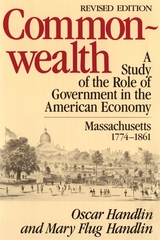 Commonwealth: A Study of the Role of Government in the American Economy: Massachusetts, 1774–1861, Revised Edition
Oscar Handlin and Mary Flug Handlin
Harvard University Press Commonwealth, when first published in 1947, was a pioneer effort to investigate the historical role of government in the American economy. It revealed for the first time the importance of political action in the development of the American free enterprise system. The present edition has been revised by the authors to take into account the research of the past two decades. Focusing on Massachusetts as a key state, Oscar and Mary Flug Handlin describe the changes in the ways the government dealt with the economy from the period of independence to the Civil War, and they analyze the social groups whose interests and ideas influenced the character of those changes.
The Handlins have re-examined both their original conclusions and the procedures by which they arrived at their formulation of the problem. They have not found it necessary to make substantial textual revisions, for both their research methods and their conclusions have stood the test of time, and their basic concepts have already been incorporated into the literature. However, they have made stylistic changes and have drastically altered their documentation, rigorously pruning the old footnotes and incorporating into the new notes important recent books and articles which treat the political and economic history of the period and the local history of the stale.
There are two significant additions to the book: a new preface and a new appendix that explain the theoretical framework through a description and demonstration of the change in the authors’ attitude and focus during the course of their original research.
This revision of Commonwealth is as cogent as the original edition, more useful to scholars because of its incorporation of the latest scholarly literature, and, as a result of the reduction in documentation, more attractive to the general reader.
 Commonwealth Catholicism: A History of Catholic Church in Virginia
Gerald P.S.J. Fogarty
University of Notre Dame Press, 2001 Commonwealth Catholicism is the first comprehensive history of the Catholic Church in the State of Virginia. In it, the distinguished historian Gerald P. Fogarty tells the story of Virginia's Catholics throughout the key periods in the state's history, from the colonial period to the present. Using archival resources, Fogarty brings to life the events and characters that comprise the Church's colorful and often turbulent history--its origins and prolonged, troubled development.
The history of the Catholic Church in Virginia is very much like the history of the Church in other parts of the South. Catholics were a tiny minority from the beginning, and remained so for much of their history. They gathered into small, isolated communities, often without a resident priest. The Catholic population in Virginia was so small, in fact, that there was only one diocese until 1974.
Catholics were often suspected of unpatriotic sympathies by their Protestant neighbors and tried to remain unnoticed, blending in, as far as possible, to the prevailing Protestant culture. Full religious tolerance for Virginia Catholics did not come until the Revolution. Reconstructing the available documentary evidence, Fogarty tells the story of these communities in full detail.
Fogarty also brings to life many of the prominent actors in the unfolding drama. Father Matthew O'Keefe, the pastor of the Norfolk region from 1852 until 1886--a period of intense Know Nothing activity--is one example. O'Keefe was asked by two men calling at the rectory door to minister to a dying man. Reaching the Elizabeth River on the edge of Portsmouth, Virginia, the two said that the dying man lay further on. O'Keefe "took a pair of revolvers from his coat, placed the men under citizen's arrest, and marched them into Portsmouth where he turned them over to the sheriff. They subsequently confessed that they had been hired to assassinate him."
This considerable accomplishment from one of the most prominent historians of American Catholicism will remain for many years a standard study on the subject of Virginia's Catholic heritage.
Gerald P. Fogarty, S.J., is William R. Kenan, Jr. Professor of Religious Studies and History at the University of Virginia. He is .
 The Commonwealth in the World, 3rd ed
J. D. B. Miller
Harvard University Press In the present proliferation of blocs, alliances and pacts, the Commonwealth remains unique. Britain’s old Colonial Empire has grown into a free, loose grouping of equal sovereign states, each respecting to the full of the others’ independence. J. D. B. Miller examines the political structure of the Commonwealth and the international status of its members, and forecasts the circumstances in which it can me expected to endure.
He contends that the commonwealth is “a concert of convenience” to which each member belongs for reasons of interest rather than of sentiment. The countries of the Commonwealth find profit in the means of consultation and economic cooperation which it offers, and in the political field confine their discussions to the larger issues on which there is a measure of common interest.
The Commonwealth in the World is one of the few works which deals conveniently with these matters in a single volume. As an Australian, Miller views his subject with the necessary detachment; and his writing is as spirited as his judgments are sound.
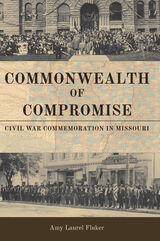 Commonwealth of Compromise: Civil War Commemoration in Missouri
Amy Laurel Fluker
University of Missouri Press, 2020 In this important new contribution to the historical literature, Amy Fluker offers a history of Civil War commemoration in Missouri, shifting focus away from the guerrilla war and devoting equal attention to Union, African American, and Confederate commemoration. She provides the most complete look yet at the construction of Civil War memory in Missouri, illuminating the particular challenges that shaped Civil War commemoration. As a slaveholding Union state on the Western frontier, Missouri found itself at odds with the popular narratives of Civil War memory developing in the North and the South. At the same time, the state’s deeply divided population clashed with one another as they tried to find meaning in their complicated and divisive history. As Missouri’s Civil War generation constructed and competed to control Civil War memory, they undertook a series of collaborative efforts that paved the way for reconciliation to a degree unmatched by other states.
Acts of Civil War commemoration have long been controversial and were never undertaken for objective purposes, but instead served to transmit particular values to future generations. Understanding this process lends informative context to contemporary debates about Civil War memory.
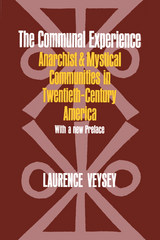 The Communal Experience: Anarchist and Mystical Communities in Twentieth Century America
Laurence R. Veysey
University of Chicago Press, 1978 The original impulse for groups to separate from society and establish communities of their own was religious. Though the religious side of this drive toward separation remains strong, the last two centuries have seen the appearance of secular communities with a socialist or anarchist orientation. In The Communal Experience, nominated for a National Book Award in 1973, Laurence Veysey explores the close resemblances between the secular and religious forms of cultural radicalism through intensive observation of four little-known communities.
Veysey compares the history of secular communities such as the early Ferrer Colony and Modern School, of Shelton, New Jersey, with contemporary anarchist communities in New York, Vermont, and New Mexico. Religious communes—"Communities of Discipline"—such as the Vedanta monasteries of the early twentieth century are compared with contemporary mystical communities in New Mexico. Distinctions between the anarchist and the mystical groups are most obvious from their approach to communal life. As Veysey shows, anarchist communities are loose, unstructured, voluntaristic; the mystics establish more rigid life-styles, focus on spiritual leaders, and hold community a secondary goal to self-realization. In a new preface written for this Phoenix Edition, he describes his return to a New Mexican mystical community and the changes that have occurred in the six years since his last visit.
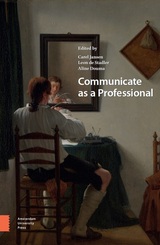 Communicate as a Professional
Carel Jansen
Amsterdam University Press, 2019 Across a wide range of programs in international higher education, students prepare themselves for a career in their professional field. Learning how to communicate as a professional is an essential part of that preparation. In order to carry out their communication tasks, professionals must possess a large repertoire of knowledge and skills. They also must be able to decide what best suits the situation and the goals they want to achieve. Already during their training, students come across a variety of communication tasks that are largely new to them. For these tasks, too, they need a broad knowledge and skills repertoire from which they can make the right choices.
'Communicate as a Professional' offers a solid foundation for students to develop the communication knowledge and skills they need, both when working as a professional after they have graduated and when following an educational program that prepares them for this future.
Communicating Faith
John Sullivan
Catholic University of America Press, 2011 This book enriches appreciation of the many ways that Christian faith is communicated. It casts light on the sensitivities, skills, and qualities necessary for the effective communication of faith, where justice is done both to the "seed" to be sown and to the "soil" being cultivated.
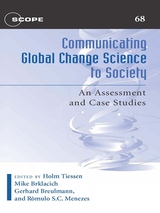 Communicating Global Change Science to Society: An Assessment and Case Studies
Edited by Holm Tiessen, Michael Brklacich, Gerhard Breulmann, and Rômulo S.C. Menezes
Island Press, 2007 National governments and research scientists may be equally concerned with issues of global environmental change, but their interests-and their timelines-are not the same. Governments are often focused on short-term effects and local impacts of global phenomena. Scientists, on the other hand, are loath to engage in speculation about the specific consequences of large-scale environmental trends.
How then can we translate scientific understanding of these trends into public policy?
Communicating Global Change Science to Society examines the growing number of instances in which governments and scientists have engaged in research projects in which the goal is to inform policy decisions. It assesses these experiences and suggests their implications for future collaborations.
The book begins with a discussion of interactions between science and policy, particularly as they relate to the broad significance of environmental change. It then addresses concerns that emerge from this discussion, including how scientific research results are communicated in democratic societies, the uses (and misuses) of scientific findings, and what the natural and social sciences could learn from each other.
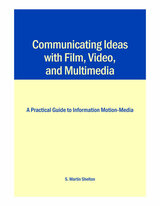 Communicating Ideas with Film, Video, and Multimedia: A Practical Guide to Information Motion-Media
S. Martin Shelton
Southern Illinois University Press, 2004
Written for a broad audience of professional informational and corporate filmmakers, film students, technical writers, and clients, Communicating Ideas with Film, Video, and Multimedia: A Practical Guide to Information Motion-Media is an insider’s perspective on the informational media industry. With over thirty-five years of experience, award-winning filmmaker S. Martin Shelton presents his astute views on the state of the profession and offers sage, constructive advice for the successful design and production of information motion-media.
Forgoing discussions of technology, Shelton instead concentrates on the communication principles that can motivate an audience to achieve a particular goal—a goal that must be realistic, worthwhile, and appropriate. His inventive approach coalesces theory of the media with its philosophy, analysis, history, and application, as well as his own informed personal opinions. This valuable guide examines how to effectively encode information in motion-media by using in-depth communication analysis and pertinent filmic design. Throughout, Shelton emphasizes that kinetic visuals, rather than audio, are the defining elements of the best motion-media communication. Organized into five parts that can be used independently or in sequence, the volume frames key topics in the industry that collectively form a cohesive strategy for motion-media design and production. First, Shelton discusses the essence of the medium as a communication tool. In the second part, he addresses the forms and functions of motion-media. The third part details communication analysis and its application. Next, Shelton delves into script design, distribution, and career growth. Lastly, he offers advice on business aspects of the profession. Told from the vantage point of a seasoned expert, Communicating Ideas with Film, Video, and Multimedia is a “how to do it” book as well as a treatise on “why to do it.” Shelton’s narrative is complemented by twenty-six illustrations (including multimedia flowcharts, sample forms, and photographs of some of the great documentary filmmakers), a variety of script formats, and a listing of the all-time best documentary films.
 Communicating Nature: How We Create and Understand Environmental Messages
Julia B. Corbett
Island Press, 2006 A broader and more comprehensive understanding of how we communicate with each other about the natural world and our relationship to it is essential to solving environmental problems. How do individuals develop beliefs and ideologies about the environment? How do we express those beliefs through communication? How are we influenced by the messages of pop culture and social institutions? And how does all this communication become part of the larger social fabric of what we know as "the environment"?
Communicating Nature explores and explains the multiple levels of everyday communication that come together to form our perceptions of the natural world. Author Julia Corbett considers all levels of communication, from communication at the individual level, to environmental messages transmitted by popular culture, to communication generated by social institutions including political and regulatory agencies, business and corporations, media outlets, and educational organizations.
The book offers a fresh and engaging introductory look at a topic of broad interest, and is an important work for students of the environment, activists and environmental professionals interested in understanding the cultural context of human-nature interactions.
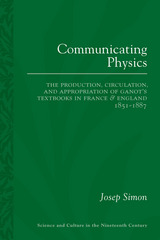 Communicating Physics: The Production, Circulation, and Appropriation of Ganot's Textbooks in France and England, 1851–1887
Josep Simon
University of Pittsburgh Press, 2011 WINNER OF THE MARC-AUGUSTE PICTET PRIZE, 2010
The textbooks written by Adolphe Ganot (1804–1887) played a major role in shaping the way physics was taught in the nineteenth century. Ganot's books were translated from their original French into more than ten languages, including English, allowing their adoption as standard works in Britain and spreading their influence as far as North America, Australia, India and Japan.
Simon's Franco-British case study looks at the role of Ganot's two textbooks: Traité élémentaire de physique expérimentale et appliquée (1851) and Cours de physique purement expérimentale (1859), and their translations into English by Edmund Atkinson. The study is novel for its international comparison of nineteenth-century physics, its acknowledgement of the role of book production on the impact of the titles and for its emphasis on the role of communication in the making of science.
 Communicating the Infinite: The Emergence of the Habad School
Naftali Loewenthal
University of Chicago Press, 1990 At the end of the eighteenth century the hasidic movement was facing an internal crisis: to what extent should the teachings of Baal Shem Tov and Maggid of Mezritch, with their implicit spiritual demands, be transmitted to the rank-and-file of the movement? Previously these teachings had been reserved for a small elite. It was at this point that the Habad school emerged with a communication ethos encouraging the transmission of esoteric to the broad reaches of the Jewish world. Communicating the Infinite explores the first two generations of the Habad school under R. Shneur Zalman of Liadi and his son R. Dov Ber and examines its early opponents.
Beginning with the different levels of communication in the teachings of the Baal Shem Tov and the Maggid and his disciples, Naftali Loewenthal traces the unfolding of the dialectic between the urge to transmit esoteric ideas and a powerful inner restraint. Gradually R. Shneur Zalman came to the fore as the prime exponent of the communication ethos. Loewenthal follows the development of his discourses up to the time of his death, when R. Dov Ber and R. Aaron Halevi Horowitz formed their respective "Lubavitch" and "Staroselye" schools. The author continues with a detailed examination of the teachings of R. Dov Ber, an inspired mystic. Central in his thought was the esoteric concept of self-abnegation, bitul, yet this combined with the quest to communicate hasidic teachings to every level of society, including women.
From the late eighteenth century onwards, the main problem for the Jewish world was posed by the fall of the walls of the social and political ghetto. Generally, the response was either to secularize, or abandon altogether, traditional Judaism or to retreat from the threatening modern world into enclave religiosity; by stressing communication, the Habad school opened the way for a middle range response that was neither a retreat into elitism nor an abandonment of tradition. Based on years of research from Hebrew and Yiddish primary source materials, Communicating the Infinite is a work of importance not only to specialists of Judaic studies but also to historians and sociologists.
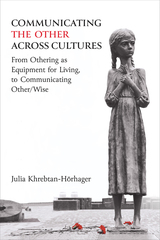 Communicating the Other across Cultures: From Othering as Equipment for Living, to Communicating Other/Wise
Dr. Julia Khrebtan-Hörhager
University of Michigan Press, 2023 Whenever political and social decisions use categories of identity such as race, religion, social class, or nationality to distinguish groups of people, they risk holding certain groups as inferior and culturally “Other.” When people employ ideologies of imperialism, colonialism, patriarchy, and classism, they position certain groups as superior or ideal/ized people. Such ideological positioning causes nations to take actions that isolate or endanger minoritized populations. This cultural Othering can lead to atrocities such as Native Americans being expelled from their native lands through the Trail of Tears, millions of Ukrainians starving to death during the Holodomor, or millions of Jews exterminated during the Holocaust.
Communicating the Other across Cultures uses examples from the United States, Western Europe, and Russia to demonstrate historical patterns of Othering people, as well as how marginalized people fight back against dominant powers that seek to silence or erase them. Deeply ingrained in our society, cultural Othering affects information in history books, children’s education, and the values upheld in our society. By taking a closer look at historical and modern instances of Othering, Julia Khrebtan-Hörhager shows examples of how different societies created ideas of social and cultural superiority or inferiority, and how deeply they are ingrained in our current society. In everyday life—the cash in your pocket, the movies shown at your local theater, museum exhibits, or politician's speeches—certain cultural ideologies are consistently upheld, while others are silenced. By exposing the communicative patterns of those in power, Khrebtan-Hörhager then suggests alternative ways of thinking, communicating, and eventually being, that offer transformative solutions for global problems.
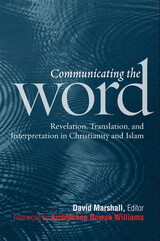 Communicating the Word: Revelation, Translation, and Interpretation in Christianity and Islam
David Marshall, Editor. Afterword by Archbishop Rowan Williams
Georgetown University Press, 2015 Communicating the Word is a record of the 2008 Building Bridges seminar, an annual dialogue between leading Christian and Muslim scholars convened by the Archbishop of Canterbury. Featuring the insights of internationally known Christian and Muslim scholars, the essays collected here focus attention on key scriptural texts but also engage with both classical and contemporary Islamic and Christian thought. Issues addressed include, among others, the different ways in which Christians and Muslims think of their scriptures as the “Word of God,” the possibilities and challenges of translating scripture, and the methods—and conflicts—involved in interpreting scripture in the past and today. In his concluding reflections, Archbishop Rowan Williams draws attention to a fundamental point emerging from these fascinating contributions: “Islam and Christianity alike give a high valuation to the conviction that God speaks to us. Grasping what that does and does not mean . . . is challenging theological work.”
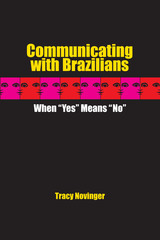 Communicating with Brazilians: When "Yes" Means "No"
By Tracy Novinger
University of Texas Press, 2004 Brazilians are gracious, friendly, fun-loving people, which makes their country a very inviting place to visit for pleasure or business. So great is their cordiality that Brazilians will say "yes" to almost any request—even when they actually mean "no"—which can be quite confusing for U.S. visitors who are used to a more direct style of communication. In fact, as Americans spend time in Brazil, they discover a number of cultural differences that can hamper their communication with Brazilians. To overcome these barriers, this book analyzes Brazilian culture and modes of communication and compares them with their American counterparts to help Americans learn to communicate successfully with Brazilians and vice versa.
To aid Americans in understanding the Brazilian perspective, Tracy Novinger presents a portrait of Brazil's history, racial fusion, economy, and contemporary lifestyles. She focuses in on many aspects of Brazilian culture, such as social organization and ranking systems; preconceptions, worldviews, and values; sexual behaviors and eating customs; thought patterns; nonverbal communication such as the use of time, space, gestures, touch, eye contact, rituals, etc.; and differences in Brazilian and American point-making styles when negotiating, persuading, and conversing. For quick reference, she concludes the book with a summary and checklist of the leading Brazilian cultural characteristics, as well as eight recommendations for enhancing intercultural communication.
Communicating with the Spirits
Gábor Klaniczay
Central European University Press, 2005 Focuses on the problem of communication with the other world: the phenomenon of spirit possession and its changing historical interpretations, the imaginary schemes elaborated for giving accounts of the journeys to the other world, for communicating with the dead, and finally the historical archetypes of this kind of religious manifestation—trance prophecy, divination, and shamanism.Recognized historians and ethnologists analyze the relationship, coexistence and conflicts of popular belief systems, Judeo-Christian mythology and demonology in medieval and modern Europe. The essays address links between rites and beliefs, folklore and literature; the legacy of various pre-Christian mythologies; the syncretic forms of ancient, medieval and modern belief- and rite-systems; "pure" examples from religious-ethnological research outside Europe to elucidate European problems.
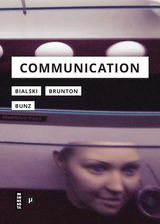 Communication
Paula Bialski
University of Minnesota Press, 2018 On contemporary communication in its various human and nonhuman forms Contemporary communication puts us not only in conversation with one another but also with our machinery. Machine communication—to communicate not just via but also with machines—is therefore the focus of this volume. Diving into digital communications history, Finn Brunton brings to the fore the alienness of computational communication by looking at network timekeeping, automated trolling, and early attempts at communication with extraterrestrial life. Picking up this fascination with inhuman communication, Mercedes Bunz then performs a close reading of interaction design and interfaces to show how technology addresses humans (as very young children). Finally, Paula Bialski shares her findings from a field study of software development, analyzing the communicative forms that occur when code is written by separate people. Today, communication unfolds merely between two or more conscious entities but often includes an invisible third party. Inspired by this drastic shift, this volume uncovers new meanings of what it means “to communicate.”
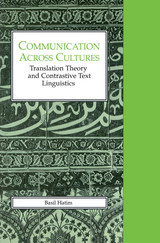 Communication Across Cultures: Translation Theory and Contrastive Text Linguistics
Basil Hatim
University of Exeter Press, 1996
While the literature on either contrastive linguistics or discourse analysis has grown immensely in the last twenty years, very little of it has ventured into fusing the two perspectives. Bearing in mind that doing discourse analysis without a contrastive base is as incomplete as doing contrastive analysis without a discourse base, the specific aim of this book is to argue that translation can add depth and breadth to both contrastive linguistics as well as to discourse analysis.
Authentic data from both spoken and written English is used throughout to add clarity to theoretical insights gained from the study of discourse processing. Each aspect of the model proposed for the analysis of texts is related separately to a problem of language processing and in domains as varied as translation, interpreting, language teaching etc. The global objectives pursued in this volume are the training of future linguists and the sensitization of users of language in general to the realities of discourse.
 Communication and Capitalism: A Critical Theory
Christian Fuchs
University of Westminster Press, 2020 ‘An authoritative analysis of the role of communication in contemporary capitalism and an important contribution to debates about the forms of domination and potentials for liberation in today’s capitalist society.’ — Professor Michael Hardt, Duke University, co-author of the tetralogy Empire, Commonwealth, Multitude, and Assembly ‘A comprehensive approach to understanding and transcending the deepening crisis of communicative capitalism. It is a major work of synthesis and essential reading for anyone wanting to know what critical analysis is and why we need it now more than ever.’ — Professor Graham Murdock, Emeritus Professor, University of Loughborough and co-editor of The Handbook of Political Economy of Communications Communication and Capitalism outlines foundations of a critical theory of communication. Going beyond Jürgen Habermas’ theory of communicative action, Christian Fuchs outlines a communicative materialism that is a critical, dialectical, humanist approach to theorising communication in society and in capitalism. The book renews Marxist Humanism as a critical theory perspective on communication and society. The author theorises communication and society by engaging with the dialectic, materialism, society, work, labour, technology, the means of communication as means of production, capitalism, class, the public sphere, alienation, ideology, nationalism, racism, authoritarianism, fascism, patriarchy, globalisation, the new imperialism, the commons, love, death, metaphysics, religion, critique, social and class struggles, praxis, and socialism. Fuchs renews the engagement with the questions of what it means to be a human and a humanist today and what dangers humanity faces today.
Communication and Community: Implications of Martin Buber's Dialogue
Ronald C. Arnett. Foreword by Maurice Friedman
Southern Illinois University Press, 1986 Martin Buber’s work suggests that real life begins with two individuals engaged in dialogue, not just taking care of one’s own needs as described in social Darwinism. Arnett argues that the end of the age of abundance demands that we give up the communicative strategies of the past and seek to work together in the midst of limited resources and an uncertain future. Today’s situation calls for an unwavering commitment to Buber’s “narrow ridge” concern for both self and community. Arnett illustrates the narrow ridge definition of interpersonal communication with rich examples. His vignettes demonstrate effective and ineffective approaches to human community. An effective approach, he makes clear, incorporates not only openness to others’ points of view but also a willingness to be persuaded.
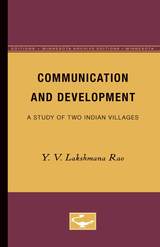 Communication and Development: A Study of Two Indian Villages
Y.V. Lakshmana Rao
University of Minnesota Press, 1966 Communication and Development was first published in 1966. Minnesota Archive Editions uses digital technology to make long-unavailable books once again accessible, and are published unaltered from the original University of Minnesota Press editions. What role does communication play in the economic, social, and political development of a community? The results of the study reported here, based on comprehensive field work in two small villages in India, throw considerable light on that question, one which is of fundamental importance to those concerned with rates and patterns of growth in any developing country. In this study, the term "communication" refers to a social process—the flow of information, the circulation of knowledge and ideas in society, the propagation and internalization of thoughts. It does not refer to the media or means of communication, such as electronics, roads and railways, or vehicles. The two villages studied, both in South India, were at contrasting stages of development. One was becoming industrialized, while the other still clung to such traditional ways as the barter system. To carry out the field work for his study, Dr. Rao lived in these villages for several months, talking at length with the people, obtaining information about their attitudes, beliefs, and opinions, and observing them and their surroundings with a trained eye. He also checked official records for pertinent information. He analyzes his findings from a psychological and sociological standpoint and, in addition, provides an intimate description of the village life. The book will be of particular interest to communications specialists, anthropologists, sociologists, political scientists, economists, and others concerned with studies of the developing countries in Asia, Africa, and Latin America.
Communication and Discourse Theory: Collected Works of the Brussels Discourse Theory Group
Edited by Leen Van Brussel, Nico Carpentier, and Benjamin De Cleen
Intellect Books, 2019 This volume gathers the work of the Brussels Discourse Theory Group, a group of critical media and communication scholars that deploy discourse theory as theoretical backbone and analytical research perspective. Drawing on a variety of case studies, ranging from the politics of reality TV to the representation of populism, Communication and Discourse Theory highlights both the radical contingent nature and the hegemonic workings of media and communication practices. The book shows the value and applicability of discourse-theoretical analysis (DTA) within the field of media and communication studies.
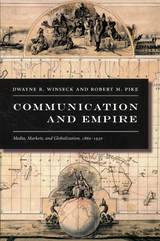 Communication and Empire: Media, Markets, and Globalization, 1860–1930
Dwayne R. Winseck and Robert M. Pike
Duke University Press, 2007 Filling in a key chapter in communications history, Dwayne R. Winseck and Robert M. Pike offer an in-depth examination of the rise of the “global media” between 1860 and 1930. They analyze the connections between the development of a global communication infrastructure, the creation of national telegraph and wireless systems, and news agencies and the content they provided. Conventional histories suggest that the growth of global communications correlated with imperial expansion: an increasing number of cables were laid as colonial powers competed for control of resources. Winseck and Pike argue that the role of the imperial contest, while significant, has been exaggerated. They emphasize how much of the global media system was in place before the high tide of imperialism in the early twentieth century, and they point to other factors that drove the proliferation of global media links, including economic booms and busts, initial steps toward multilateralism and international law, and the formation of corporate cartels. Drawing on extensive research in corporate and government archives, Winseck and Pike illuminate the actions of companies and cartels during the late nineteenth century and early twentieth, in many different parts of the globe, including Africa, Asia, and Central and South America as well as Europe and North America. The complex history they relate shows how cable companies exploited or transcended national policies in the creation of the global cable network, how private corporations and government agencies interacted, and how individual reformers fought to eliminate cartels and harmonize the regulation of world communications. In Communication and Empire, the multinational conglomerates, regulations, and the politics of imperialism and anti-imperialism as well as the cries for reform of the late nineteenth century and early twentieth emerge as the obvious forerunners of today’s global media.
 Communication and Litigation: Case Studies of Famous Trials
Janice Schuetz
Southern Illinois University Press, 1988
Examination of seven famous trials, each concluding with an evaluation of the trial by a lawyer, judge, law professor, or communication scholar.
The Washington Post coverage of the John Hinckley case preceding the trial demonstrates the effects media may have on a trial. The Haymarket riot trial serves as an example of opening statements in a storytelling form.
By analyzing the trial of Bruno Richard Hauptmann, Schuetz and Snedaker explain direct examination according to its purpose, legal rules, ordering of witnesses, verbal and nonverbal techniques of interrogation, and tactics for introducing evidence.
The cross-examination in the Sacco-Vanzetti case shows how advocates enhance or decrease their persuasiveness by adopting communication maneuvers. Closing arguments in the Rosenberg trial took the form of a refutative story with a dual persuasive and instructional content.
The Supreme Court appeal in the Sam Sheppard case demonstrates the procedures, form, content, and style of arguments of appellate briefs. The Chicago Eight trial is an example of trial as theatre.
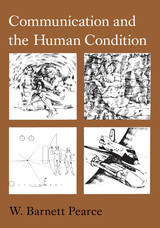 Communication and the Human Condition
W. Barnett Pearce
Southern Illinois University Press, 1989 Starting with the premise that we live in communication (rather than standing outside communication and using it for secondary purposes), Pearce claims that people who live in various cultures and historical epochs not only communicate differently but experience different ways of being human because they communicate differently. This century, he notes, ushered in the "communication revolution," the discovery that communication is far more important and central to the human condition than ever before realized. Essential to the communication revolution is the recognition that multiple forms of discourse exist in contemporary human society. Further, these forms of discourse are not benign; they comprise alternative ways of being human. Thus communication theory must encompass all that it "means to live a life, the shape of social institutions and cultural traditions, the pragmatics of social action, and the poetics of social order."
Communication and Women's Friendships: Parallels and Intersections in Literature and Life
Janet Doubler Ward
University of Wisconsin Press, 1993 Eleven original essays offer a variety of perspectives on the changing ways in which women's friendships have been viewed. The contributors discuss the fundamental values of women's friendships and communication in order to understand the many parallels and intersections between literature and life. This anthology suggests that women's friendships are to be greatly valued—indeed treasured —as significant parts of women's lives.
Communication, Control and Security Challenges for the Smart Grid
S.M. Muyeen
The Institution of Engineering and Technology, 2017 The Smart Grid is a modern electricity grid allowing for distributed, renewable intermittent generation, partly owned by consumers. This requires advanced control and communication technologies in order to provide high quality power supply and secure generation, transmission and distribution. This book outlines these emerging technologies.
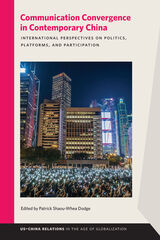 Communication Convergence in Contemporary China: International Perspectives on Politics, Platforms, and Participation
Patrick Shaou-Whea Dodge
Michigan State University Press, 2020 In a speech opening the nineteenth Chinese Communist Party Congress meeting in October 2017, President Xi Jinping spoke of a “New Era” characterized by new types of communication convergence between the government, Party, and state media. His speech signaled that the role of the media is now more important than ever in cultivating the Party’s image at home and disseminating it abroad. Indeed, communication technologies, people, and platforms are converging in new ways around the world, not just in China. This process raises important questions about information flows, control, and regulation that directly affect the future of US–China relations. Just a year before Xi proclaimed the New Era, scholars had convened in Beijing at a conference cohosted by the Communication University of China and the US-based National Communication Association to address these questions. How do China and the United States envision each other, and how do our interlinked imaginaries create both opportunities for and obstacles to greater understanding and strengthened relations? Would the convergence of new media technologies, Party control, and emerging notions of netizenship in China lead to a new age of opening and reform, greater Party domination, or perhaps some new and intriguing combination of repression and freedom? Communication Convergence in Contemporary China presents international perspectives on US–China relations in this New Era with case studies that offer readers informative snapshots of how these relations are changing on the ground, in the lived realities of our daily communication habits.
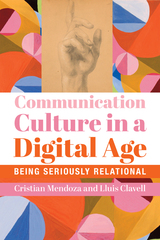 Communication Culture in a Digital Age: Being Seriously Relational
Cristian Mendoza
St. Augustine's Press, 2023 Why are human beings so attracted to information and communication technologies? Developments in this field have formed new social networks around these technologies and that seem to compete with pre-existing structures in human lives. Cristian Mendoza and Lluís Clavell confront this phenomenon and its effect on human happiness, but have no desire to condemn the trajectory of human reliance on communication technology. Rather, they see an opportunity to explore human nature at greater depths. Only in this way can our use of technology properly support human activity and not sabotage our grasp of reality.
Mendoza and Clavell's treatment of this topic renders an important philosophical conversation about digital realities and how they can actually make human life more human. This book provides a framework for using human attraction to information and communication tech for human benefit. It can be done! The authors apply the work of old and new masters to help open the new horizons of communication technology wherein human beings can flourish.
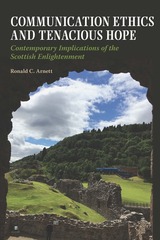 Communication Ethics and Tenacious Hope: Contemporary Implications of the Scottish Enlightenment
Ronald C. Arnett with Foreword by Thomas M. Lessl
Southern Illinois University Press, 2022 WINNER, 2022 National Communication Association Top Single-Author Book of the Year in the Communication Ethics Division!
Tenacious hope, the heart of a just and free society
During the Enlightenment, Scottish intellectuals and administrators met the demands of profit and progress while shepherding concerns for self and other, individual and community, and family and work. Communication Ethics and Tenacious Hope captures the “unity of contraries,” offering the Scottish Enlightenment as an exemplar of tenacious hope countering the excesses of individualism. Ronald C. Arnett reveals two stories: the struggle between optimism and tenacious hope, and optimism’s ultimate triumph in the exclusion of difference and the reification of progress as an ultimate good.
In chapters that detail the legacies of Lord Provost George Drummond, Adam Smith, David Hume, Thomas Reid, George Campbell, Adam Ferguson, and Sir Walter Scott, Arnett highlights the problematic nature of optimism and the ethical agency of tenacious hope. Arnett illustrates the creative union of education and administration, the ability to accept doubt within systems of knowledge and imagination, and an abiding connection to local soil. As principles of progress, free will, and capitalism swept Europe, proponents of optimism envisioned a world of consumerism and absolutes. In contrast, practitioners of tenacious hope embraced uncertainty and compassion as pragmatic necessities.
This work continues Arnett’s scholarship, articulating the vital importance of communication ethics. Those seeking to discern and support a temporal sense of the good in this historical moment will find in this timely work the means to pursue, hold, and nourish tenacious hope. This insightful theorization of the Scottish Enlightenment distills the substance of a just and free society for meeting dangerous and uncertain times.
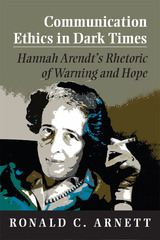 Communication Ethics in Dark Times: Hannah Arendt's Rhetoric of Warning and Hope
Ronald C. Arnett
Southern Illinois University Press, 2013 Renowned in the disciplines of political theory and philosophy, Hannah Arendt’s searing critiques of modernity continue to resonate in other fields of thought decades after she wrote them. In Communication Ethics in Dark Times: Hannah Arendt’s Rhetoric of Warning and Hope, author Ronald C. Arnett offers a groundbreaking examination of fifteen of Arendt’s major scholarly works, considering the German writer’s contributions to the areas of rhetoric and communication ethics for the first time. Arnett focuses on Arendt’s use of the phrase “dark times” to describe the mistakes of modernity, defined by Arendt as the post-Enlightenment social conditions, discourses, and processes ruled by principles of efficiency, progress, and individual autonomy. These principles, Arendt argues, have led humanity down a path of folly, banality, and hubris. Throughout his interpretive evaluation, Arnett illuminates the implications of Arendt’s persistent metaphor of “dark times” and engages the question, How might communication ethics counter the tenets of dark times and their consequences? A compelling study of Hannah Arendt’s most noteworthy works and their connections to the fields of rhetoric and communication ethics, Communication Ethics in Dark Times provides an illuminating introduction for students and scholars of communication ethics and rhetoric, and a tool with which experts may discover new insights, connections, and applications to these fields.
Top Book Award for Philosophy of Communication Ethics by Communication Ethics Division of the National Communication Association, 2013
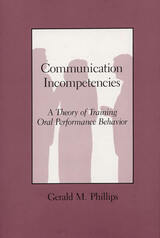 Communication Incompetencies: A Theory of Training Oral Performance Behavior
Gerald M. Phillips
Southern Illinois University Press, 1991
Gerald M. Phillips draws on his twenty-five-year, five-thousand-client experience with the Pennsylvania State University Reticence Program to present a new theory of modification of “inept” communication behavior.
That experience has convinced Phillips that communication is arbitrary and rulebound rather than a process of inspiration. He demonstrates that communication problems can be described as errors that can be detected and classified in order to fit a remediation pattern. Regardless of the source of error, the remedy is to train the individual to avoid or eliminate errors—thus, orderly procedure will result in competent performance.
Inept communicators must be made aware of the obligations and constraints imposed by deep structures that require us to achieve a degree of formal order in our language, without which our discourse becomes incomprehensible.
Communication, Pedagogy, and the Gospel of Mark
Elizabeth E. Shively
SBL Press, 2016 Reflections on the relationship between research and teaching
Using Mark as a test case, scholars address questions like: How should my research and my approach to the text play out in the classroom? What differences should my academic context and my students' expectations make? How should new approaches and innovations inform interpretation and teaching? This resource enables biblical studies instructors to explore various interpretative approaches and to begin to engage pedagogical issues in our changing world.
Features:
- Ideas that may be adapted for teaching any biblical text
- Diverse perspectives from nine experts in their fields
- Essays include tips, ideas, and lesson plans for the classroom
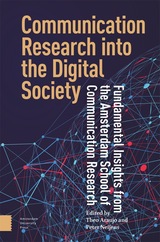 Communication Research into the Digital Society: Fundamental Insights from the Amsterdam School of Communication Research
Theo Araujo
Amsterdam University Press, 2024 Media and communication have become ubiquitous in today’s societies and affect all aspects of life. On an individual level, they impact how we learn about the world, how we entertain ourselves, and how we interact with others. On an organisational level, the interactions between media and organisations, such as political parties, NGOs, businesses and brands, shape organisations’ reputation, legitimacy, trust and (financial) performance, as well as individuals’ consumer, political, social and health behaviours. At the societal level, media and communication are crucial for shaping public opinion on current issues such as climate change, sustainability, diversity, and well-being. Media challenges are widespread and include mis- and disinformation, the negative impact of algorithms on our information diets, challenges to our privacy, cyberbullying, media addiction, and unwanted persuasion, among many others. All this makes the study of media and communication crucial.
This book provides a broad overview of the ways in which people create, use, and experience their media environment, and the role of media and communication for individuals, organisations, and society. The chapters in the book were written by researchers from the Amsterdam School of Communication Research (ASCoR) on the occasion of its 25th anniversary. ASCoR is today the largest research institute of its kind in Europe and has developed over the past 25 years into one of the best communications research institutes in the world.
 Communication Skills for Conservation Professionals
Susan K. Jacobson
Island Press, 1999 Community and public support are essential to the success of conservation and resource management programs. Often, the level of support received depends on whether or not the goals and importance of the program have been clearly explained to the public, the press, or policymakers. Without good communication, even the best programs are liable to fail. Communication Skills for Conservation Professionals provides in-depth guidance on achieving conservation goals through better communications. It introduces communication approaches -- marketing and mass media, citizen participation, public information, environmental interpretation, and conservation education activities -- and offers scores of real-world examples and straightforward advice that will help conservationists develop the the skills they need to communicate effectively. Following an introductory chapter that provides an overview of the communication process, the book: - describes research techniques for gathering background information and targeting audiences
- outlines the steps involved in developing a communications campaign
- explains how to use mass media-from giving interviews to writing news releases and holding press conferences
- provides examples for developing interpretive media for conservation
- explores long-term conservation education strategies
- presents program evaluation techniques to determine the level of success achieved, or to identify steps for improvement
Throughout, the author presents a rich storehouse of examples, guidelines, and planning tools for all kinds of communication challenges. Strategies and materials that have been used by organizations across the country -- from the U.S. Fish and Wildlife Service to The Nature Conservancy, from Adirondack Park to Yellowstone National Park -- are featured, providing both inspiration and support for others involved with similar projects. Communication Skills for Conservation Professionals is a much-needed contribution to the environmental literature that will play a vital role in helping scientists, managers, concerned citizens, and students to more effectively communicate their knowledge and concern about the environment, and to achieve greater professional and community success with their environmental campaigns.
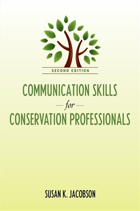 Communication Skills for Conservation Professionals
Susan K. Jacobson
Island Press, 2009 Whether you are managing wetlands, protecting endangered species, or restoring ecosystems, you need to be able to communicate effectively in order to solve conservation and resource management problems. Communication Skills for Conservation Professionals can help you do just that—it is a practical and inspiring book that provides user-friendly guidance on achieving conservation goals through effective communication. Following introductory chapters that draw on research from communication, psychology, sociology, and education to highlight elements critical for effective communication, the book describes how to gather background information and target audiences, explains how public relations can influence attitudes and behaviors, and outlines how to design and conduct a communications campaign. In addition, it provides step-by-step guidance for using print, broadcast, and electronic mass media; demonstrates methods for developing public talks, interpretive brochures, exhibits, and trails; and explores long-term conservation education strategies for students and adults. This second edition of a widely praised book, originally published in 1999, includes new material on working with stakeholders, volunteers, and other groups to multiply conservation success. It also expands on the use of electronic media with examples of conservation Web pages, blogs, e-newsletters, and other new media. The book’s citations have been updated to include a host of Web sites and other electronic sources useful for planning and implementing communication programs. Communication Skills for Conservation Professionals is a valuable addition to the conservationist’s toolbox that will help scientists, managers, concerned citizens, and students communicate more effectively.
Communication Technologies for Networked Smart Cities
Shree Krishna Sharma
The Institution of Engineering and Technology, 2021 One of the crucial challenges for future smart cities is to devise a citywide network infrastructure capable of effectively guaranteeing resource-efficient and reliable communications while managing the complexity of heterogeneous devices and access technologies. This edited book highlights and showcases state of the art research and innovations in 5G and beyond wireless communications technologies for connected smart cities. The main objectives of this work include the exploration of recent advances and application potentials of various communication technologies as promising enablers for future networked smart cities, the investigation of design-specific issues for the integration of different architectural components of smart cities, and addressing various challenges and identifying opportunities in terms of interoperability of potential solutions.
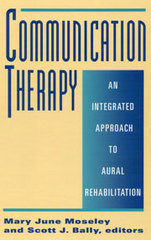 Communication Therapy: An Integrated Approach to Aural Rehabilitation
Mary June Moseley
Gallaudet University Press, 1996 This new book for students and professionals emphasizes a functional approach to aural rehabilitation refined during the past several years. It details the use of an integrated therapy strategy designed to meet a variety of needs for each client while simultaneously working on multiple communication skill areas. Particular care has been taken to address the different requirements of deaf and hard of hearing adolescents and adults, including information about the unique needs of the culturally Deaf population. Throughout this practical text, clinicians receive encouragement to learn American Sign Language to enhance communication with Deaf clients.
Communication Therapy calls upon the expertise of various authorities well-versed in integrated therapy. They explain fully the state-of-the-art practices for all therapy areas, from global areas in communication therapy, to technology for aural rehabilitation, auditory skills, speechreading, speech and voice, pronunciation, and language skills, and telephone communication training. Case studies demonstrate the effectiveness of the integrated approach, making this book a significant advancement in communication therapy.
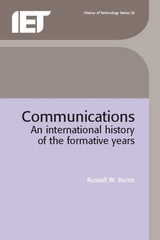 Communications: An international history of the formative years
Russell W. Burns
The Institution of Engineering and Technology, 2004 Communications: An international history of the formative years traces the evolution of communications from 500 BC, when fire beacons were used for signalling, to the 1940s, when high definition television systems were developed for the entertainment, education and enlightenment of society. The book does not simply provide a chronicle of dates and events, nor is it a descriptive catalogue of devices and systems. Rather, it discusses the essential factors - technical, political, social, economic and general - that enabled the evolution of modern communications. The author has taken a contextual approach to show the influence of one discipline upon another, and the unfolding story has been widely illustrated with contemporary quotations, allowing the progress of communications to be seen from the perspective of the times and not from the standpoint of a later generation.
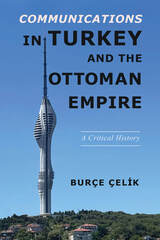 Communications in Turkey and the Ottoman Empire: A Critical History
Burçe Çelik
University of Illinois Press, 2023 De-Westernizing the communications history of Turkey and its imperial predecessor The history of communications in the Ottoman Empire and Turkey contradicts the widespread belief that communications is a byproduct of modern capitalism and other Western forces. Burçe Çelik uses a decolonial perspective to analyze the historical commodification and militarization of communications and how it affected production and practice for oppressed populations like women, the working class, and ethnic and religious minorities. Moving from the mid-nineteenth century through today, Çelik places networks within the changing geopolitical landscape and the evolution of modern capitalism in relationship to struggles involving a range of social and political actors. Throughout, she challenges Anglo- and Eurocentric assumptions that see the non-West as an ahistorical imitation of, or aberration from, the development of Western communications. Ambitious and comprehensive, Communications in Turkey and the Ottoman Empire merges political economy with social history to challenge Western-centered assumptions about the origins and development of modern communications.
|
|

